Sustainable Physical Methods for Agricultural Waste Management
VerifiedAdded on 2022/12/23
|20
|5389
|1
AI Summary
This document discusses sustainable physical methods used for the management of agricultural waste biomass. It covers topics such as crop cultivation patterns, types of waste, and innovative ideas for waste utilization. The document also explores the concept of renewable energy and the difference between biomass and fossil fuels.
Contribute Materials
Your contribution can guide someone’s learning journey. Share your
documents today.
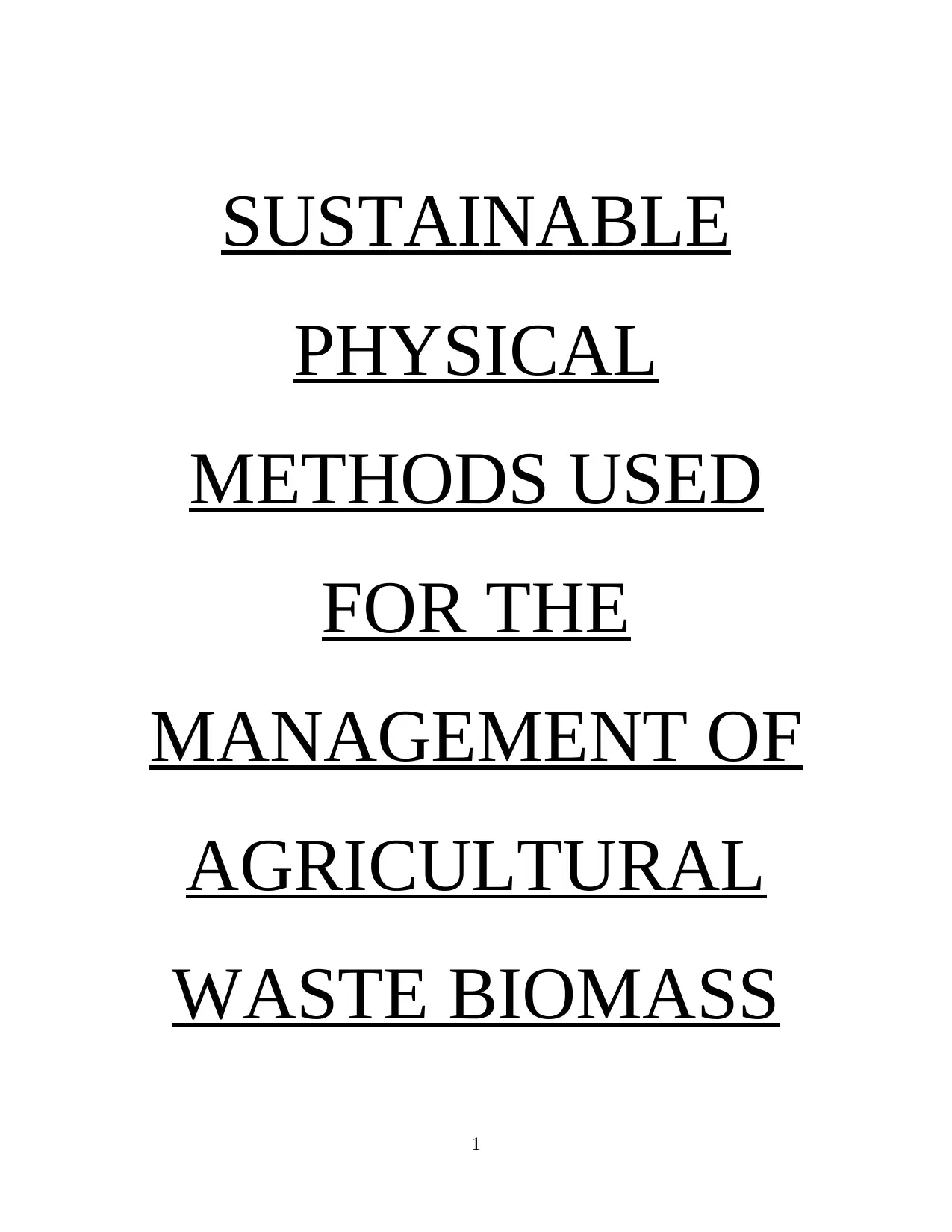
SUSTAINABLE
PHYSICAL
METHODS USED
FOR THE
MANAGEMENT OF
AGRICULTURAL
WASTE BIOMASS
1
PHYSICAL
METHODS USED
FOR THE
MANAGEMENT OF
AGRICULTURAL
WASTE BIOMASS
1
Secure Best Marks with AI Grader
Need help grading? Try our AI Grader for instant feedback on your assignments.
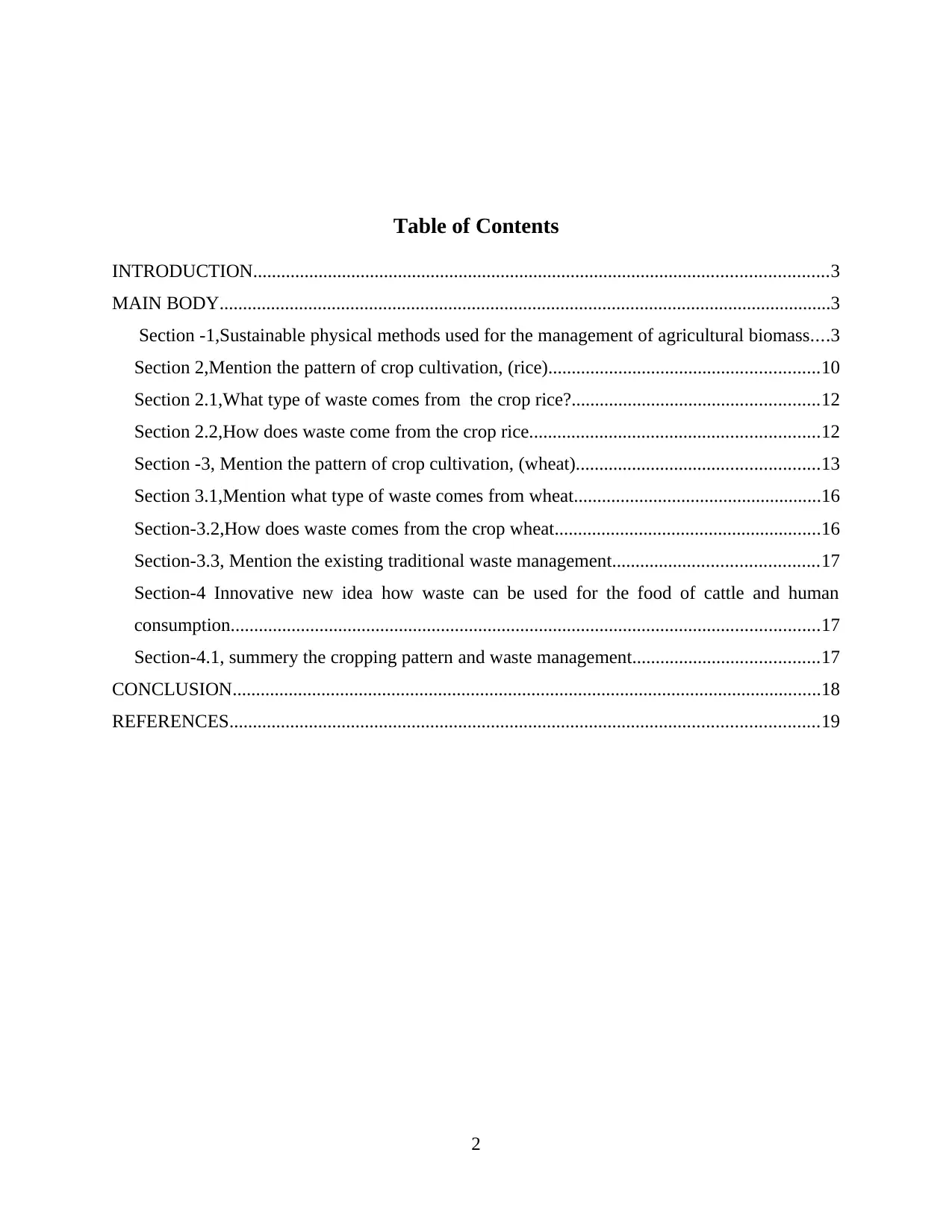
Table of Contents
INTRODUCTION...........................................................................................................................3
MAIN BODY...................................................................................................................................3
Section -1,Sustainable physical methods used for the management of agricultural biomass....3
Section 2,Mention the pattern of crop cultivation, (rice)..........................................................10
Section 2.1,What type of waste comes from the crop rice?.....................................................12
Section 2.2,How does waste come from the crop rice..............................................................12
Section -3, Mention the pattern of crop cultivation, (wheat)....................................................13
Section 3.1,Mention what type of waste comes from wheat.....................................................16
Section-3.2,How does waste comes from the crop wheat.........................................................16
Section-3.3, Mention the existing traditional waste management............................................17
Section-4 Innovative new idea how waste can be used for the food of cattle and human
consumption..............................................................................................................................17
Section-4.1, summery the cropping pattern and waste management........................................17
CONCLUSION..............................................................................................................................18
REFERENCES..............................................................................................................................19
2
INTRODUCTION...........................................................................................................................3
MAIN BODY...................................................................................................................................3
Section -1,Sustainable physical methods used for the management of agricultural biomass....3
Section 2,Mention the pattern of crop cultivation, (rice)..........................................................10
Section 2.1,What type of waste comes from the crop rice?.....................................................12
Section 2.2,How does waste come from the crop rice..............................................................12
Section -3, Mention the pattern of crop cultivation, (wheat)....................................................13
Section 3.1,Mention what type of waste comes from wheat.....................................................16
Section-3.2,How does waste comes from the crop wheat.........................................................16
Section-3.3, Mention the existing traditional waste management............................................17
Section-4 Innovative new idea how waste can be used for the food of cattle and human
consumption..............................................................................................................................17
Section-4.1, summery the cropping pattern and waste management........................................17
CONCLUSION..............................................................................................................................18
REFERENCES..............................................................................................................................19
2
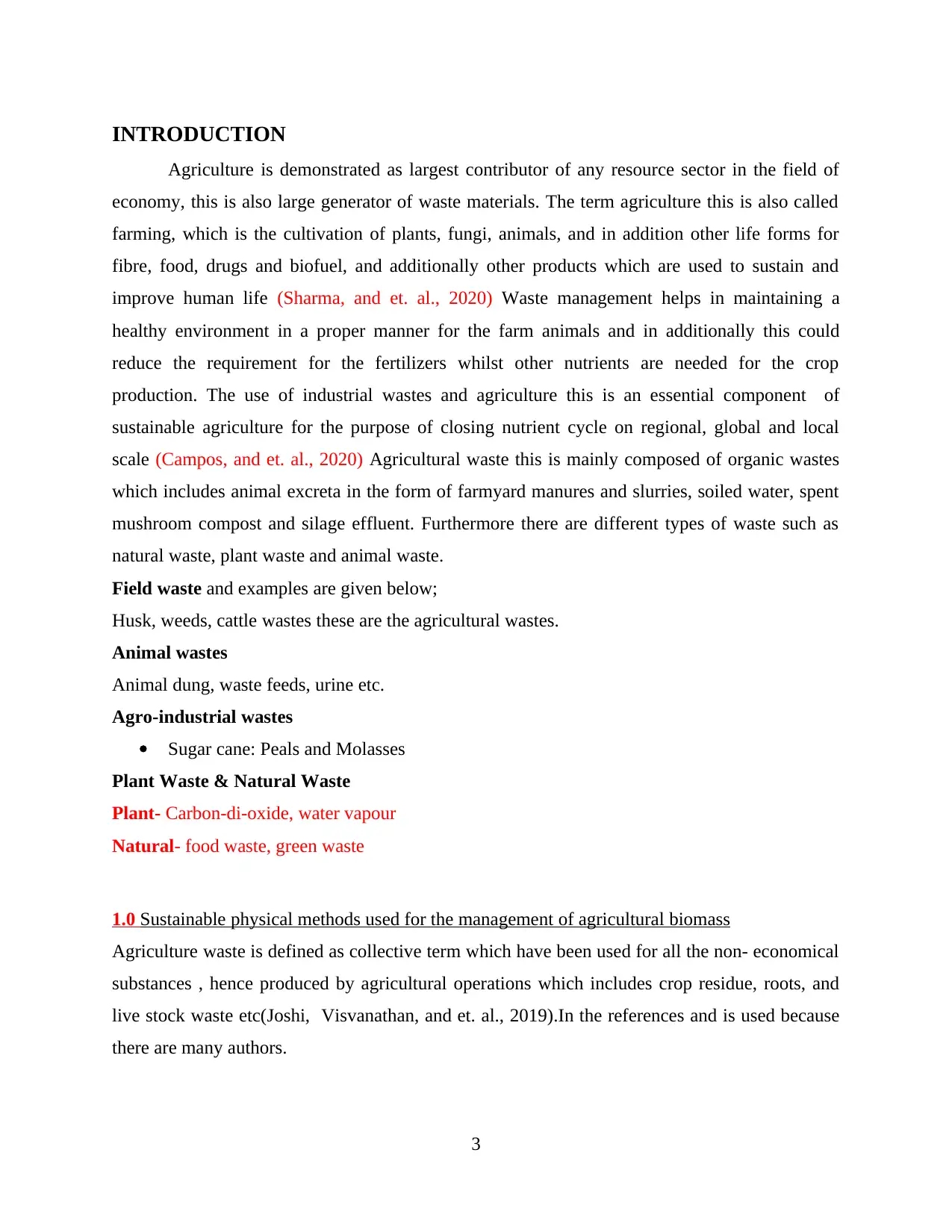
INTRODUCTION
Agriculture is demonstrated as largest contributor of any resource sector in the field of
economy, this is also large generator of waste materials. The term agriculture this is also called
farming, which is the cultivation of plants, fungi, animals, and in addition other life forms for
fibre, food, drugs and biofuel, and additionally other products which are used to sustain and
improve human life (Sharma, and et. al., 2020) Waste management helps in maintaining a
healthy environment in a proper manner for the farm animals and in additionally this could
reduce the requirement for the fertilizers whilst other nutrients are needed for the crop
production. The use of industrial wastes and agriculture this is an essential component of
sustainable agriculture for the purpose of closing nutrient cycle on regional, global and local
scale (Campos, and et. al., 2020) Agricultural waste this is mainly composed of organic wastes
which includes animal excreta in the form of farmyard manures and slurries, soiled water, spent
mushroom compost and silage effluent. Furthermore there are different types of waste such as
natural waste, plant waste and animal waste.
Field waste and examples are given below;
Husk, weeds, cattle wastes these are the agricultural wastes.
Animal wastes
Animal dung, waste feeds, urine etc.
Agro-industrial wastes
Sugar cane: Peals and Molasses
Plant Waste & Natural Waste
Plant- Carbon-di-oxide, water vapour
Natural- food waste, green waste
1.0 Sustainable physical methods used for the management of agricultural biomass
Agriculture waste is defined as collective term which have been used for all the non- economical
substances , hence produced by agricultural operations which includes crop residue, roots, and
live stock waste etc(Joshi, Visvanathan, and et. al., 2019).In the references and is used because
there are many authors.
3
Agriculture is demonstrated as largest contributor of any resource sector in the field of
economy, this is also large generator of waste materials. The term agriculture this is also called
farming, which is the cultivation of plants, fungi, animals, and in addition other life forms for
fibre, food, drugs and biofuel, and additionally other products which are used to sustain and
improve human life (Sharma, and et. al., 2020) Waste management helps in maintaining a
healthy environment in a proper manner for the farm animals and in additionally this could
reduce the requirement for the fertilizers whilst other nutrients are needed for the crop
production. The use of industrial wastes and agriculture this is an essential component of
sustainable agriculture for the purpose of closing nutrient cycle on regional, global and local
scale (Campos, and et. al., 2020) Agricultural waste this is mainly composed of organic wastes
which includes animal excreta in the form of farmyard manures and slurries, soiled water, spent
mushroom compost and silage effluent. Furthermore there are different types of waste such as
natural waste, plant waste and animal waste.
Field waste and examples are given below;
Husk, weeds, cattle wastes these are the agricultural wastes.
Animal wastes
Animal dung, waste feeds, urine etc.
Agro-industrial wastes
Sugar cane: Peals and Molasses
Plant Waste & Natural Waste
Plant- Carbon-di-oxide, water vapour
Natural- food waste, green waste
1.0 Sustainable physical methods used for the management of agricultural biomass
Agriculture waste is defined as collective term which have been used for all the non- economical
substances , hence produced by agricultural operations which includes crop residue, roots, and
live stock waste etc(Joshi, Visvanathan, and et. al., 2019).In the references and is used because
there are many authors.
3
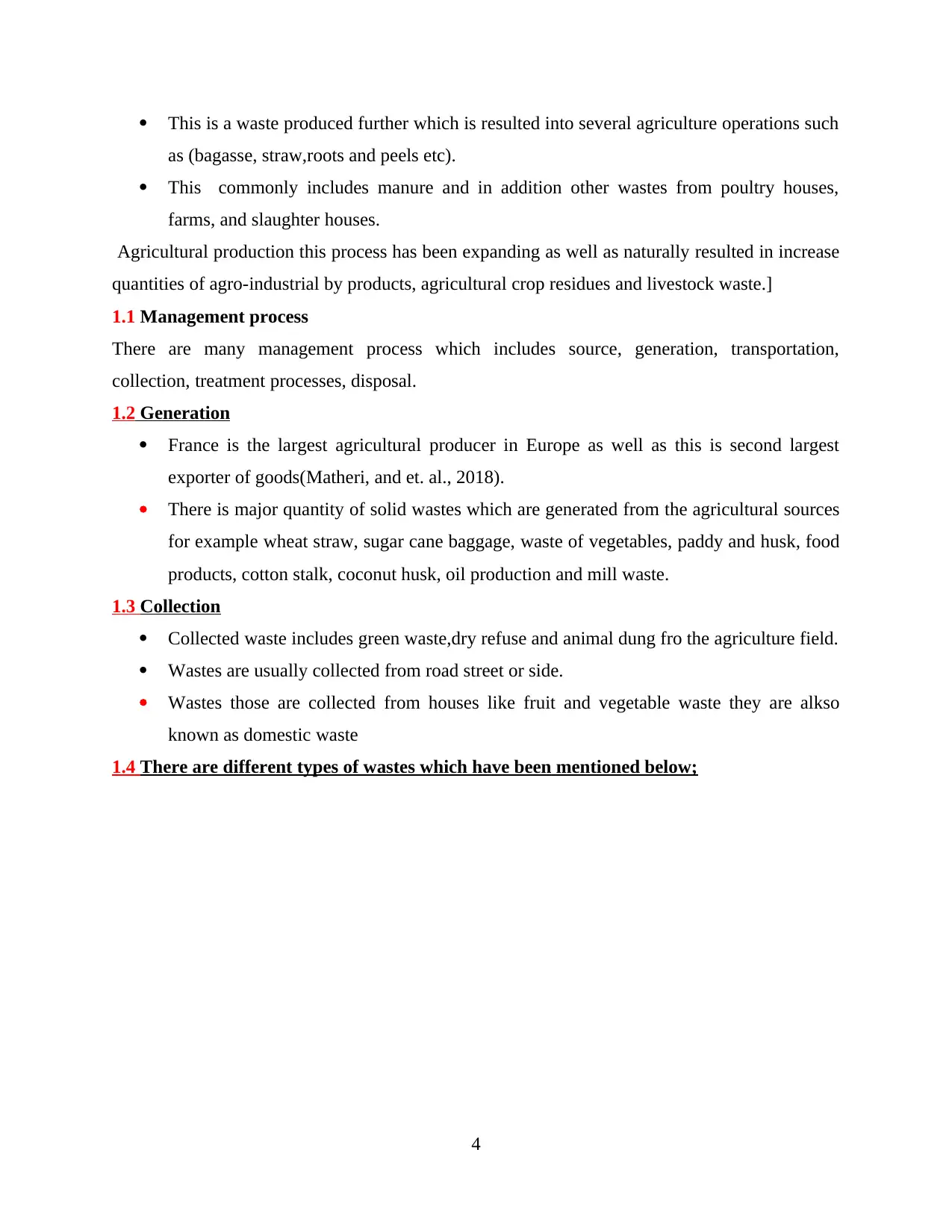
This is a waste produced further which is resulted into several agriculture operations such
as (bagasse, straw,roots and peels etc).
This commonly includes manure and in addition other wastes from poultry houses,
farms, and slaughter houses.
Agricultural production this process has been expanding as well as naturally resulted in increase
quantities of agro-industrial by products, agricultural crop residues and livestock waste.]
1.1 Management process
There are many management process which includes source, generation, transportation,
collection, treatment processes, disposal.
1.2 Generation
France is the largest agricultural producer in Europe as well as this is second largest
exporter of goods(Matheri, and et. al., 2018).
There is major quantity of solid wastes which are generated from the agricultural sources
for example wheat straw, sugar cane baggage, waste of vegetables, paddy and husk, food
products, cotton stalk, coconut husk, oil production and mill waste.
1.3 Collection
Collected waste includes green waste,dry refuse and animal dung fro the agriculture field.
Wastes are usually collected from road street or side.
Wastes those are collected from houses like fruit and vegetable waste they are alkso
known as domestic waste
1.4 There are different types of wastes which have been mentioned below;
4
as (bagasse, straw,roots and peels etc).
This commonly includes manure and in addition other wastes from poultry houses,
farms, and slaughter houses.
Agricultural production this process has been expanding as well as naturally resulted in increase
quantities of agro-industrial by products, agricultural crop residues and livestock waste.]
1.1 Management process
There are many management process which includes source, generation, transportation,
collection, treatment processes, disposal.
1.2 Generation
France is the largest agricultural producer in Europe as well as this is second largest
exporter of goods(Matheri, and et. al., 2018).
There is major quantity of solid wastes which are generated from the agricultural sources
for example wheat straw, sugar cane baggage, waste of vegetables, paddy and husk, food
products, cotton stalk, coconut husk, oil production and mill waste.
1.3 Collection
Collected waste includes green waste,dry refuse and animal dung fro the agriculture field.
Wastes are usually collected from road street or side.
Wastes those are collected from houses like fruit and vegetable waste they are alkso
known as domestic waste
1.4 There are different types of wastes which have been mentioned below;
4
Secure Best Marks with AI Grader
Need help grading? Try our AI Grader for instant feedback on your assignments.
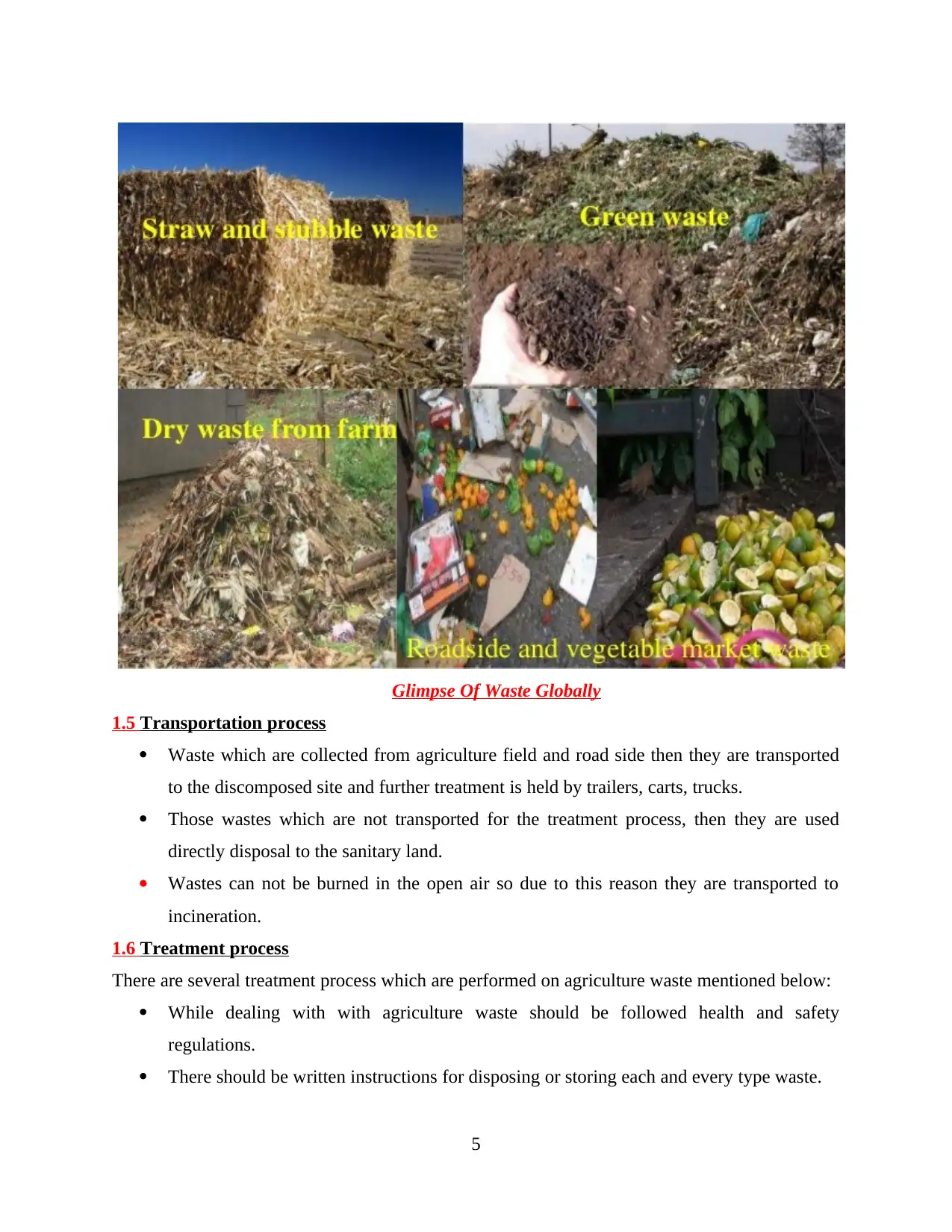
Glimpse Of Waste Globally
1.5 Transportation process
Waste which are collected from agriculture field and road side then they are transported
to the discomposed site and further treatment is held by trailers, carts, trucks.
Those wastes which are not transported for the treatment process, then they are used
directly disposal to the sanitary land.
Wastes can not be burned in the open air so due to this reason they are transported to
incineration.
1.6 Treatment process
There are several treatment process which are performed on agriculture waste mentioned below:
While dealing with with agriculture waste should be followed health and safety
regulations.
There should be written instructions for disposing or storing each and every type waste.
5
1.5 Transportation process
Waste which are collected from agriculture field and road side then they are transported
to the discomposed site and further treatment is held by trailers, carts, trucks.
Those wastes which are not transported for the treatment process, then they are used
directly disposal to the sanitary land.
Wastes can not be burned in the open air so due to this reason they are transported to
incineration.
1.6 Treatment process
There are several treatment process which are performed on agriculture waste mentioned below:
While dealing with with agriculture waste should be followed health and safety
regulations.
There should be written instructions for disposing or storing each and every type waste.
5
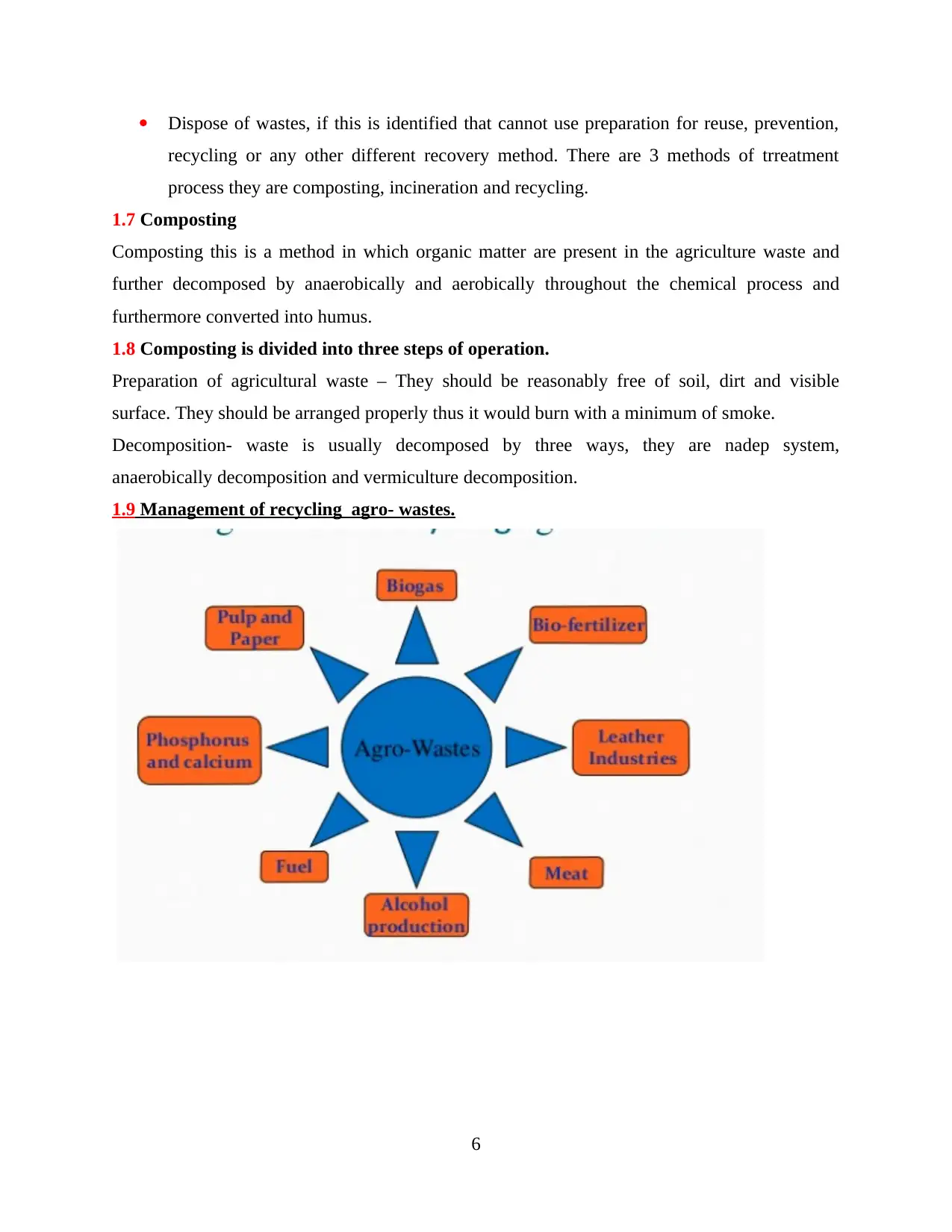
Dispose of wastes, if this is identified that cannot use preparation for reuse, prevention,
recycling or any other different recovery method. There are 3 methods of trreatment
process they are composting, incineration and recycling.
1.7 Composting
Composting this is a method in which organic matter are present in the agriculture waste and
further decomposed by anaerobically and aerobically throughout the chemical process and
furthermore converted into humus.
1.8 Composting is divided into three steps of operation.
Preparation of agricultural waste – They should be reasonably free of soil, dirt and visible
surface. They should be arranged properly thus it would burn with a minimum of smoke.
Decomposition- waste is usually decomposed by three ways, they are nadep system,
anaerobically decomposition and vermiculture decomposition.
1.9 Management of recycling agro- wastes.
6
recycling or any other different recovery method. There are 3 methods of trreatment
process they are composting, incineration and recycling.
1.7 Composting
Composting this is a method in which organic matter are present in the agriculture waste and
further decomposed by anaerobically and aerobically throughout the chemical process and
furthermore converted into humus.
1.8 Composting is divided into three steps of operation.
Preparation of agricultural waste – They should be reasonably free of soil, dirt and visible
surface. They should be arranged properly thus it would burn with a minimum of smoke.
Decomposition- waste is usually decomposed by three ways, they are nadep system,
anaerobically decomposition and vermiculture decomposition.
1.9 Management of recycling agro- wastes.
6

1.10 Conventional energy- There are conventional sources mentioned below;
1. Fossil fuel – oil, coal, and gas they are present in limited amount therefore canot be
replaced.
2. Nuclear fuels- They do have limited amount of uranium for the the purpose of nuclear
fission reactor no matter if the advanced technologies permit to reprocess the used fuel.
3. This is very difficulty to evaluate nowadays how will not renewable fuels would last, but
most of them causes problems in the terms of environmental sustainability and in
economics. The pollution which is caused due to emission for fossil fuel they cause main
problems.
2.0 Renewable energy
1.- Renewable energy this is also known as sustainable energy who's sources comes from the
natural environment and on the other hand this energy could be renewed.
2.- This energy mainly exist in perpetually form as well as abundance in the environment.
3- This is nearly inexhaustible.
4- Such kind of energy is a clean alternative to fossil fuels.
5- The energy which is derived from the natural process that is plenished continuously and in
addition defined as the renewable energy.
2.1 Renewable energy sources are mentioned in the framework of EU policies.
Renewable energy sources they do plays a key role in accomplishing the European goals,
when there is energy supply as well as demand for the climate change .
Renewable energy source they usually expect to make economic growth more and more
sustainable.
Renewable energy source they could trigger the dynamic growth in addition for the
foreseeable future.
2.2 European energy does meet three challenges
How to get a predictable and secure energy supply as well as that could be affordable too
at reasonable price.
7
1. Fossil fuel – oil, coal, and gas they are present in limited amount therefore canot be
replaced.
2. Nuclear fuels- They do have limited amount of uranium for the the purpose of nuclear
fission reactor no matter if the advanced technologies permit to reprocess the used fuel.
3. This is very difficulty to evaluate nowadays how will not renewable fuels would last, but
most of them causes problems in the terms of environmental sustainability and in
economics. The pollution which is caused due to emission for fossil fuel they cause main
problems.
2.0 Renewable energy
1.- Renewable energy this is also known as sustainable energy who's sources comes from the
natural environment and on the other hand this energy could be renewed.
2.- This energy mainly exist in perpetually form as well as abundance in the environment.
3- This is nearly inexhaustible.
4- Such kind of energy is a clean alternative to fossil fuels.
5- The energy which is derived from the natural process that is plenished continuously and in
addition defined as the renewable energy.
2.1 Renewable energy sources are mentioned in the framework of EU policies.
Renewable energy sources they do plays a key role in accomplishing the European goals,
when there is energy supply as well as demand for the climate change .
Renewable energy source they usually expect to make economic growth more and more
sustainable.
Renewable energy source they could trigger the dynamic growth in addition for the
foreseeable future.
2.2 European energy does meet three challenges
How to get a predictable and secure energy supply as well as that could be affordable too
at reasonable price.
7
Paraphrase This Document
Need a fresh take? Get an instant paraphrase of this document with our AI Paraphraser
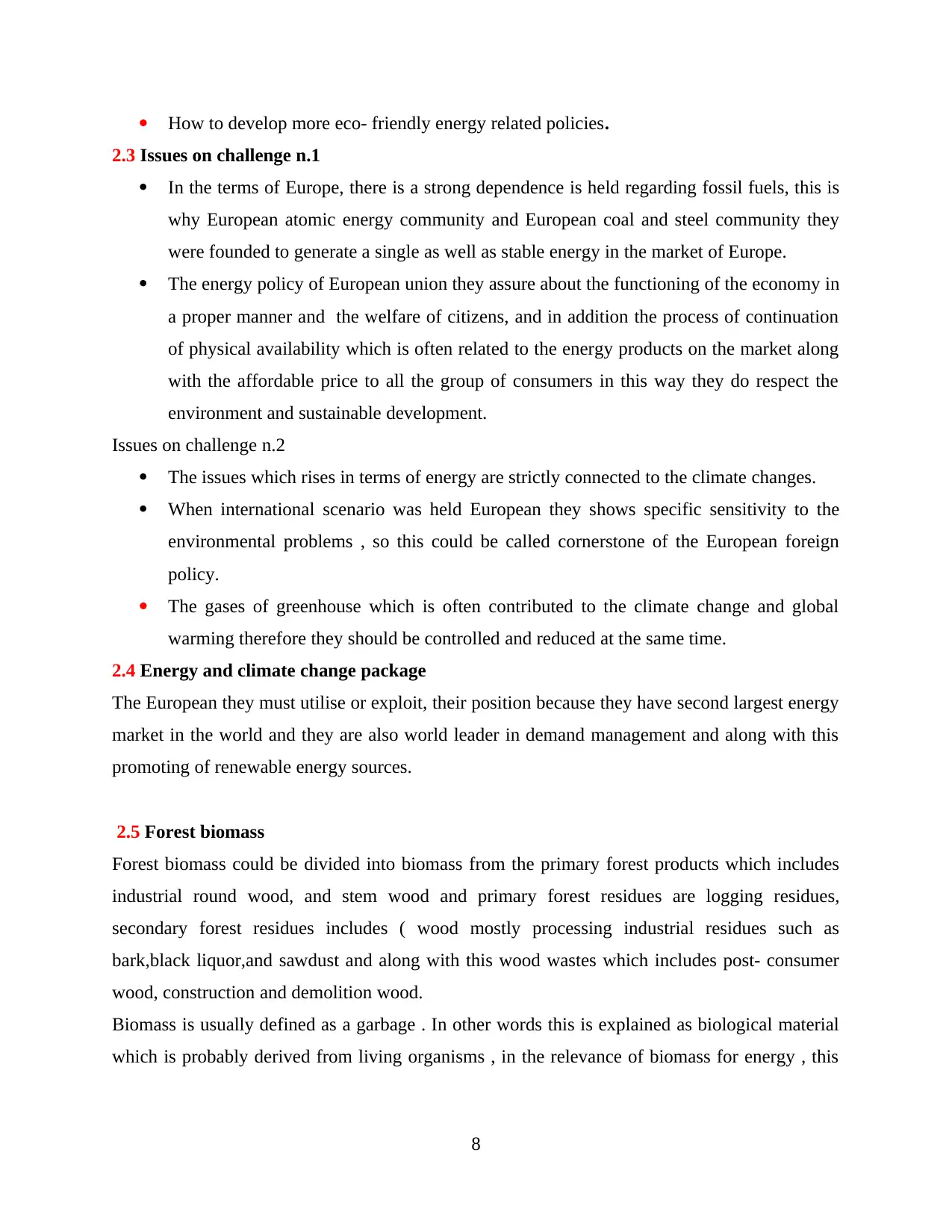
How to develop more eco- friendly energy related policies.
2.3 Issues on challenge n.1
In the terms of Europe, there is a strong dependence is held regarding fossil fuels, this is
why European atomic energy community and European coal and steel community they
were founded to generate a single as well as stable energy in the market of Europe.
The energy policy of European union they assure about the functioning of the economy in
a proper manner and the welfare of citizens, and in addition the process of continuation
of physical availability which is often related to the energy products on the market along
with the affordable price to all the group of consumers in this way they do respect the
environment and sustainable development.
Issues on challenge n.2
The issues which rises in terms of energy are strictly connected to the climate changes.
When international scenario was held European they shows specific sensitivity to the
environmental problems , so this could be called cornerstone of the European foreign
policy.
The gases of greenhouse which is often contributed to the climate change and global
warming therefore they should be controlled and reduced at the same time.
2.4 Energy and climate change package
The European they must utilise or exploit, their position because they have second largest energy
market in the world and they are also world leader in demand management and along with this
promoting of renewable energy sources.
2.5 Forest biomass
Forest biomass could be divided into biomass from the primary forest products which includes
industrial round wood, and stem wood and primary forest residues are logging residues,
secondary forest residues includes ( wood mostly processing industrial residues such as
bark,black liquor,and sawdust and along with this wood wastes which includes post- consumer
wood, construction and demolition wood.
Biomass is usually defined as a garbage . In other words this is explained as biological material
which is probably derived from living organisms , in the relevance of biomass for energy , this
8
2.3 Issues on challenge n.1
In the terms of Europe, there is a strong dependence is held regarding fossil fuels, this is
why European atomic energy community and European coal and steel community they
were founded to generate a single as well as stable energy in the market of Europe.
The energy policy of European union they assure about the functioning of the economy in
a proper manner and the welfare of citizens, and in addition the process of continuation
of physical availability which is often related to the energy products on the market along
with the affordable price to all the group of consumers in this way they do respect the
environment and sustainable development.
Issues on challenge n.2
The issues which rises in terms of energy are strictly connected to the climate changes.
When international scenario was held European they shows specific sensitivity to the
environmental problems , so this could be called cornerstone of the European foreign
policy.
The gases of greenhouse which is often contributed to the climate change and global
warming therefore they should be controlled and reduced at the same time.
2.4 Energy and climate change package
The European they must utilise or exploit, their position because they have second largest energy
market in the world and they are also world leader in demand management and along with this
promoting of renewable energy sources.
2.5 Forest biomass
Forest biomass could be divided into biomass from the primary forest products which includes
industrial round wood, and stem wood and primary forest residues are logging residues,
secondary forest residues includes ( wood mostly processing industrial residues such as
bark,black liquor,and sawdust and along with this wood wastes which includes post- consumer
wood, construction and demolition wood.
Biomass is usually defined as a garbage . In other words this is explained as biological material
which is probably derived from living organisms , in the relevance of biomass for energy , this
8
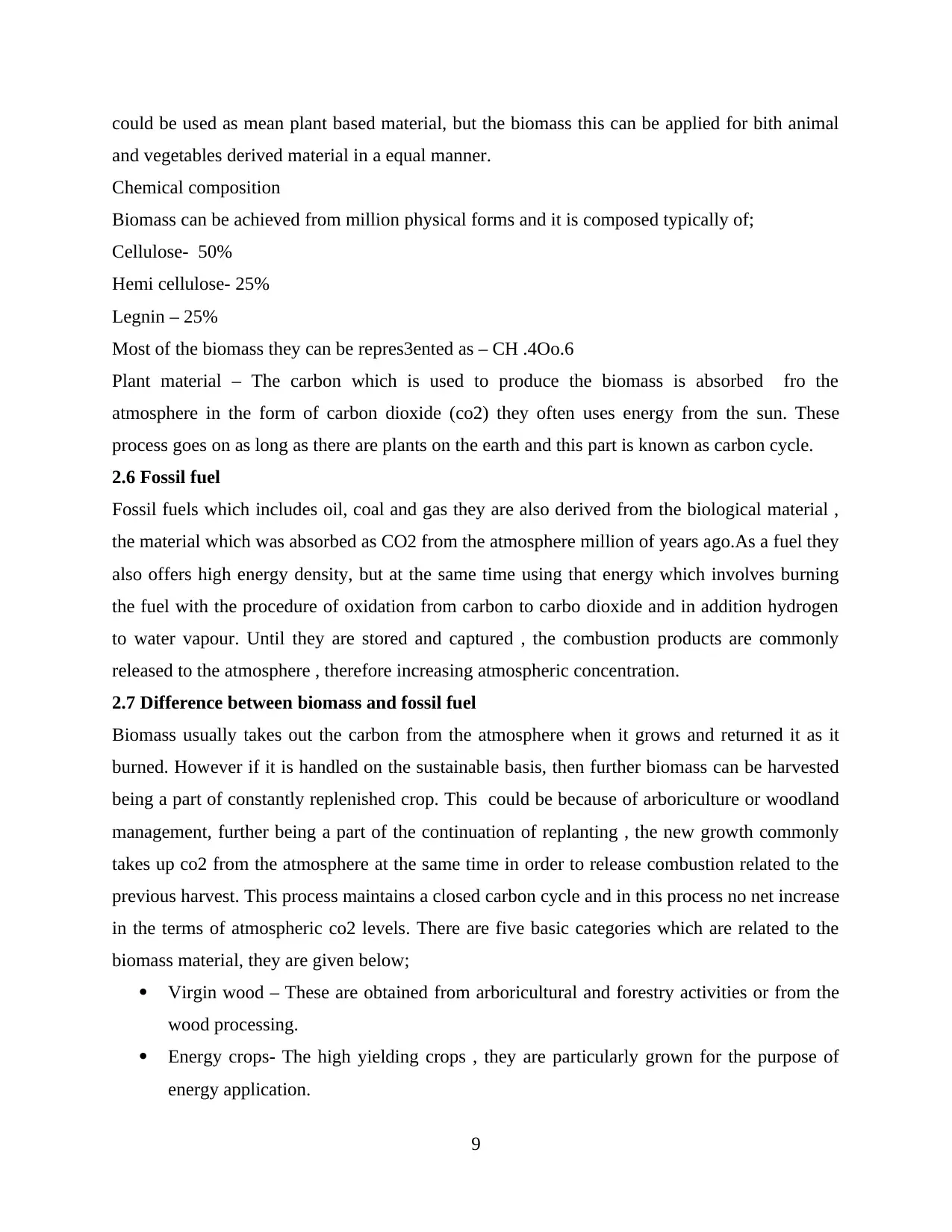
could be used as mean plant based material, but the biomass this can be applied for bith animal
and vegetables derived material in a equal manner.
Chemical composition
Biomass can be achieved from million physical forms and it is composed typically of;
Cellulose- 50%
Hemi cellulose- 25%
Legnin – 25%
Most of the biomass they can be repres3ented as – CH .4Oo.6
Plant material – The carbon which is used to produce the biomass is absorbed fro the
atmosphere in the form of carbon dioxide (co2) they often uses energy from the sun. These
process goes on as long as there are plants on the earth and this part is known as carbon cycle.
2.6 Fossil fuel
Fossil fuels which includes oil, coal and gas they are also derived from the biological material ,
the material which was absorbed as CO2 from the atmosphere million of years ago.As a fuel they
also offers high energy density, but at the same time using that energy which involves burning
the fuel with the procedure of oxidation from carbon to carbo dioxide and in addition hydrogen
to water vapour. Until they are stored and captured , the combustion products are commonly
released to the atmosphere , therefore increasing atmospheric concentration.
2.7 Difference between biomass and fossil fuel
Biomass usually takes out the carbon from the atmosphere when it grows and returned it as it
burned. However if it is handled on the sustainable basis, then further biomass can be harvested
being a part of constantly replenished crop. This could be because of arboriculture or woodland
management, further being a part of the continuation of replanting , the new growth commonly
takes up co2 from the atmosphere at the same time in order to release combustion related to the
previous harvest. This process maintains a closed carbon cycle and in this process no net increase
in the terms of atmospheric co2 levels. There are five basic categories which are related to the
biomass material, they are given below;
Virgin wood – These are obtained from arboricultural and forestry activities or from the
wood processing.
Energy crops- The high yielding crops , they are particularly grown for the purpose of
energy application.
9
and vegetables derived material in a equal manner.
Chemical composition
Biomass can be achieved from million physical forms and it is composed typically of;
Cellulose- 50%
Hemi cellulose- 25%
Legnin – 25%
Most of the biomass they can be repres3ented as – CH .4Oo.6
Plant material – The carbon which is used to produce the biomass is absorbed fro the
atmosphere in the form of carbon dioxide (co2) they often uses energy from the sun. These
process goes on as long as there are plants on the earth and this part is known as carbon cycle.
2.6 Fossil fuel
Fossil fuels which includes oil, coal and gas they are also derived from the biological material ,
the material which was absorbed as CO2 from the atmosphere million of years ago.As a fuel they
also offers high energy density, but at the same time using that energy which involves burning
the fuel with the procedure of oxidation from carbon to carbo dioxide and in addition hydrogen
to water vapour. Until they are stored and captured , the combustion products are commonly
released to the atmosphere , therefore increasing atmospheric concentration.
2.7 Difference between biomass and fossil fuel
Biomass usually takes out the carbon from the atmosphere when it grows and returned it as it
burned. However if it is handled on the sustainable basis, then further biomass can be harvested
being a part of constantly replenished crop. This could be because of arboriculture or woodland
management, further being a part of the continuation of replanting , the new growth commonly
takes up co2 from the atmosphere at the same time in order to release combustion related to the
previous harvest. This process maintains a closed carbon cycle and in this process no net increase
in the terms of atmospheric co2 levels. There are five basic categories which are related to the
biomass material, they are given below;
Virgin wood – These are obtained from arboricultural and forestry activities or from the
wood processing.
Energy crops- The high yielding crops , they are particularly grown for the purpose of
energy application.
9
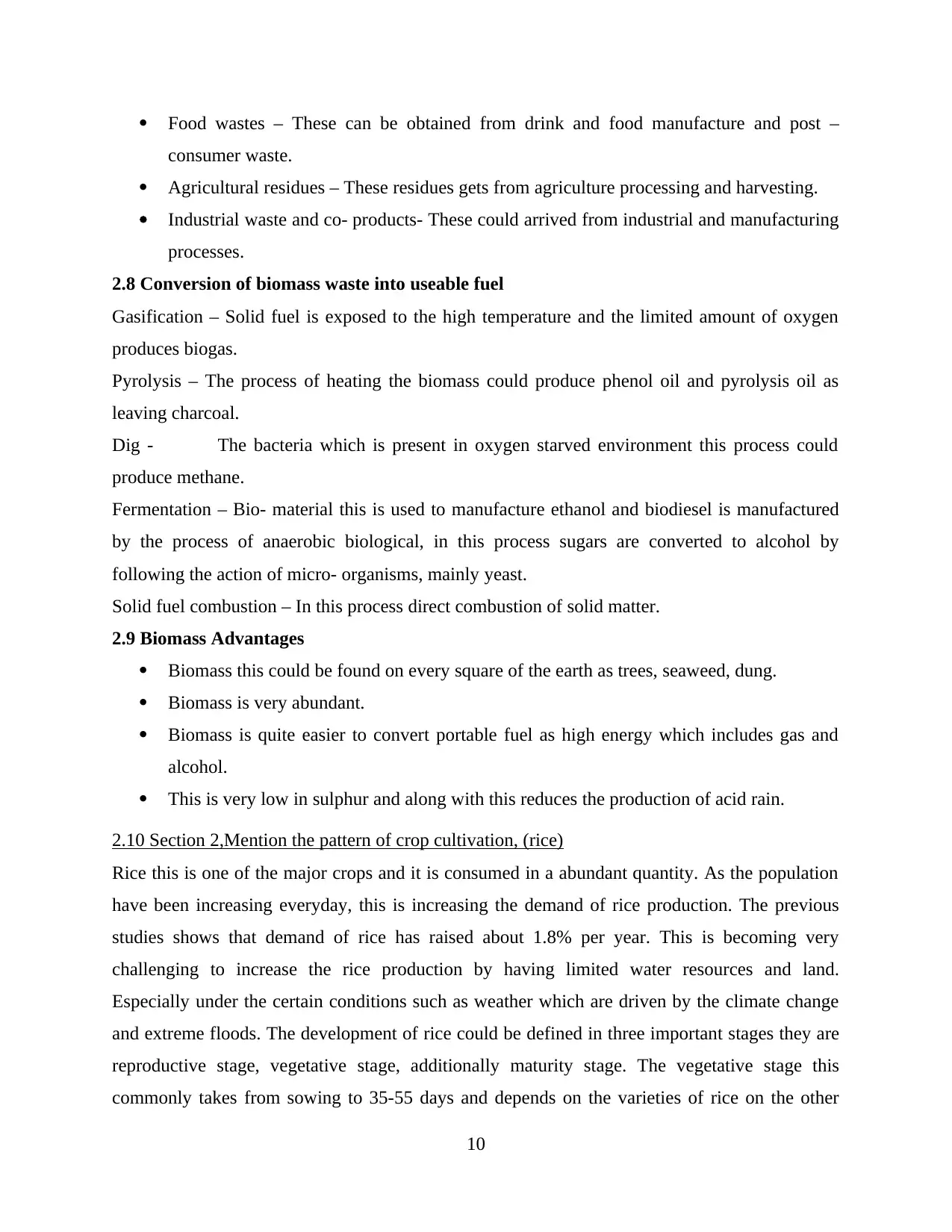
Food wastes – These can be obtained from drink and food manufacture and post –
consumer waste.
Agricultural residues – These residues gets from agriculture processing and harvesting.
Industrial waste and co- products- These could arrived from industrial and manufacturing
processes.
2.8 Conversion of biomass waste into useable fuel
Gasification – Solid fuel is exposed to the high temperature and the limited amount of oxygen
produces biogas.
Pyrolysis – The process of heating the biomass could produce phenol oil and pyrolysis oil as
leaving charcoal.
Dig - The bacteria which is present in oxygen starved environment this process could
produce methane.
Fermentation – Bio- material this is used to manufacture ethanol and biodiesel is manufactured
by the process of anaerobic biological, in this process sugars are converted to alcohol by
following the action of micro- organisms, mainly yeast.
Solid fuel combustion – In this process direct combustion of solid matter.
2.9 Biomass Advantages
Biomass this could be found on every square of the earth as trees, seaweed, dung.
Biomass is very abundant.
Biomass is quite easier to convert portable fuel as high energy which includes gas and
alcohol.
This is very low in sulphur and along with this reduces the production of acid rain.
2.10 Section 2,Mention the pattern of crop cultivation, (rice)
Rice this is one of the major crops and it is consumed in a abundant quantity. As the population
have been increasing everyday, this is increasing the demand of rice production. The previous
studies shows that demand of rice has raised about 1.8% per year. This is becoming very
challenging to increase the rice production by having limited water resources and land.
Especially under the certain conditions such as weather which are driven by the climate change
and extreme floods. The development of rice could be defined in three important stages they are
reproductive stage, vegetative stage, additionally maturity stage. The vegetative stage this
commonly takes from sowing to 35-55 days and depends on the varieties of rice on the other
10
consumer waste.
Agricultural residues – These residues gets from agriculture processing and harvesting.
Industrial waste and co- products- These could arrived from industrial and manufacturing
processes.
2.8 Conversion of biomass waste into useable fuel
Gasification – Solid fuel is exposed to the high temperature and the limited amount of oxygen
produces biogas.
Pyrolysis – The process of heating the biomass could produce phenol oil and pyrolysis oil as
leaving charcoal.
Dig - The bacteria which is present in oxygen starved environment this process could
produce methane.
Fermentation – Bio- material this is used to manufacture ethanol and biodiesel is manufactured
by the process of anaerobic biological, in this process sugars are converted to alcohol by
following the action of micro- organisms, mainly yeast.
Solid fuel combustion – In this process direct combustion of solid matter.
2.9 Biomass Advantages
Biomass this could be found on every square of the earth as trees, seaweed, dung.
Biomass is very abundant.
Biomass is quite easier to convert portable fuel as high energy which includes gas and
alcohol.
This is very low in sulphur and along with this reduces the production of acid rain.
2.10 Section 2,Mention the pattern of crop cultivation, (rice)
Rice this is one of the major crops and it is consumed in a abundant quantity. As the population
have been increasing everyday, this is increasing the demand of rice production. The previous
studies shows that demand of rice has raised about 1.8% per year. This is becoming very
challenging to increase the rice production by having limited water resources and land.
Especially under the certain conditions such as weather which are driven by the climate change
and extreme floods. The development of rice could be defined in three important stages they are
reproductive stage, vegetative stage, additionally maturity stage. The vegetative stage this
commonly takes from sowing to 35-55 days and depends on the varieties of rice on the other
10
Secure Best Marks with AI Grader
Need help grading? Try our AI Grader for instant feedback on your assignments.
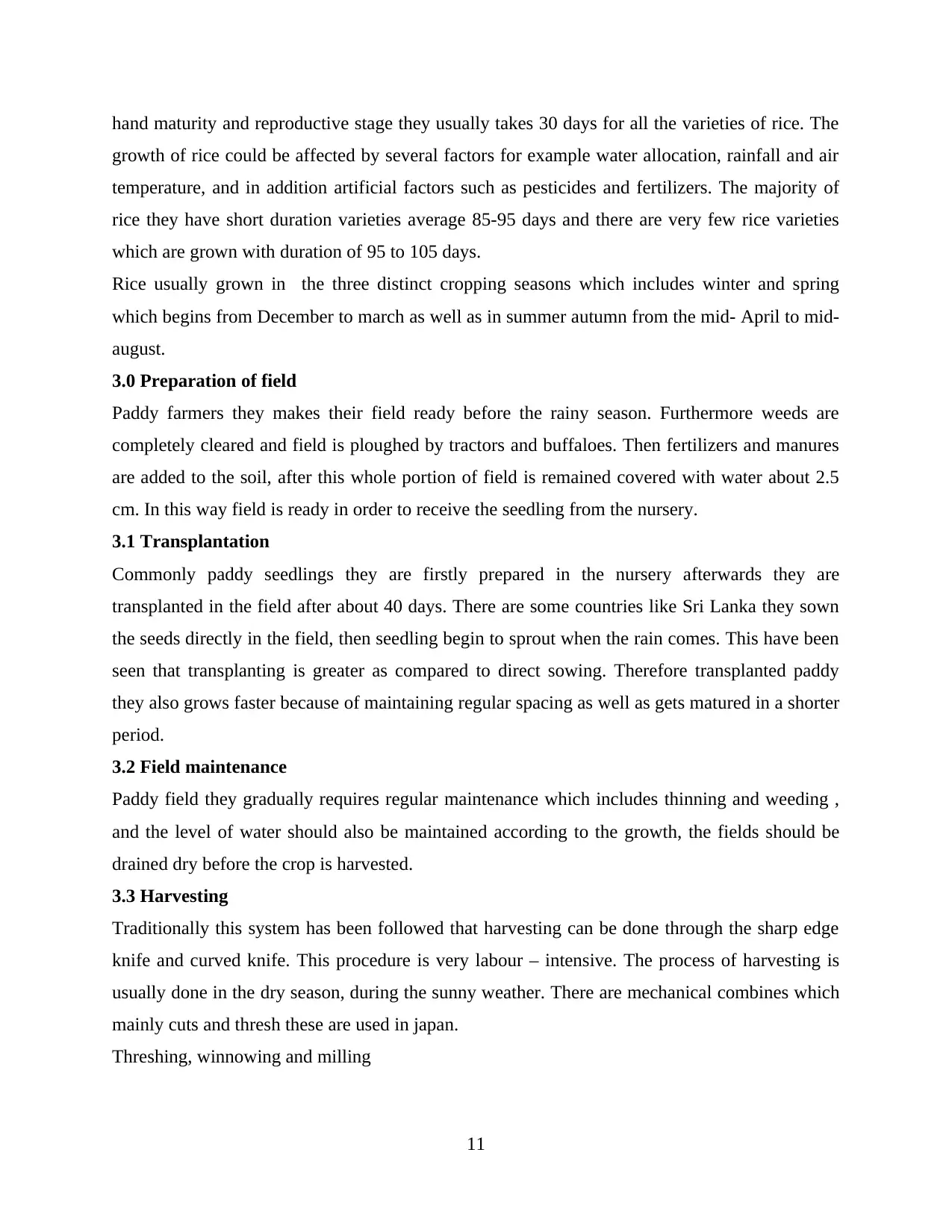
hand maturity and reproductive stage they usually takes 30 days for all the varieties of rice. The
growth of rice could be affected by several factors for example water allocation, rainfall and air
temperature, and in addition artificial factors such as pesticides and fertilizers. The majority of
rice they have short duration varieties average 85-95 days and there are very few rice varieties
which are grown with duration of 95 to 105 days.
Rice usually grown in the three distinct cropping seasons which includes winter and spring
which begins from December to march as well as in summer autumn from the mid- April to mid-
august.
3.0 Preparation of field
Paddy farmers they makes their field ready before the rainy season. Furthermore weeds are
completely cleared and field is ploughed by tractors and buffaloes. Then fertilizers and manures
are added to the soil, after this whole portion of field is remained covered with water about 2.5
cm. In this way field is ready in order to receive the seedling from the nursery.
3.1 Transplantation
Commonly paddy seedlings they are firstly prepared in the nursery afterwards they are
transplanted in the field after about 40 days. There are some countries like Sri Lanka they sown
the seeds directly in the field, then seedling begin to sprout when the rain comes. This have been
seen that transplanting is greater as compared to direct sowing. Therefore transplanted paddy
they also grows faster because of maintaining regular spacing as well as gets matured in a shorter
period.
3.2 Field maintenance
Paddy field they gradually requires regular maintenance which includes thinning and weeding ,
and the level of water should also be maintained according to the growth, the fields should be
drained dry before the crop is harvested.
3.3 Harvesting
Traditionally this system has been followed that harvesting can be done through the sharp edge
knife and curved knife. This procedure is very labour – intensive. The process of harvesting is
usually done in the dry season, during the sunny weather. There are mechanical combines which
mainly cuts and thresh these are used in japan.
Threshing, winnowing and milling
11
growth of rice could be affected by several factors for example water allocation, rainfall and air
temperature, and in addition artificial factors such as pesticides and fertilizers. The majority of
rice they have short duration varieties average 85-95 days and there are very few rice varieties
which are grown with duration of 95 to 105 days.
Rice usually grown in the three distinct cropping seasons which includes winter and spring
which begins from December to march as well as in summer autumn from the mid- April to mid-
august.
3.0 Preparation of field
Paddy farmers they makes their field ready before the rainy season. Furthermore weeds are
completely cleared and field is ploughed by tractors and buffaloes. Then fertilizers and manures
are added to the soil, after this whole portion of field is remained covered with water about 2.5
cm. In this way field is ready in order to receive the seedling from the nursery.
3.1 Transplantation
Commonly paddy seedlings they are firstly prepared in the nursery afterwards they are
transplanted in the field after about 40 days. There are some countries like Sri Lanka they sown
the seeds directly in the field, then seedling begin to sprout when the rain comes. This have been
seen that transplanting is greater as compared to direct sowing. Therefore transplanted paddy
they also grows faster because of maintaining regular spacing as well as gets matured in a shorter
period.
3.2 Field maintenance
Paddy field they gradually requires regular maintenance which includes thinning and weeding ,
and the level of water should also be maintained according to the growth, the fields should be
drained dry before the crop is harvested.
3.3 Harvesting
Traditionally this system has been followed that harvesting can be done through the sharp edge
knife and curved knife. This procedure is very labour – intensive. The process of harvesting is
usually done in the dry season, during the sunny weather. There are mechanical combines which
mainly cuts and thresh these are used in japan.
Threshing, winnowing and milling
11
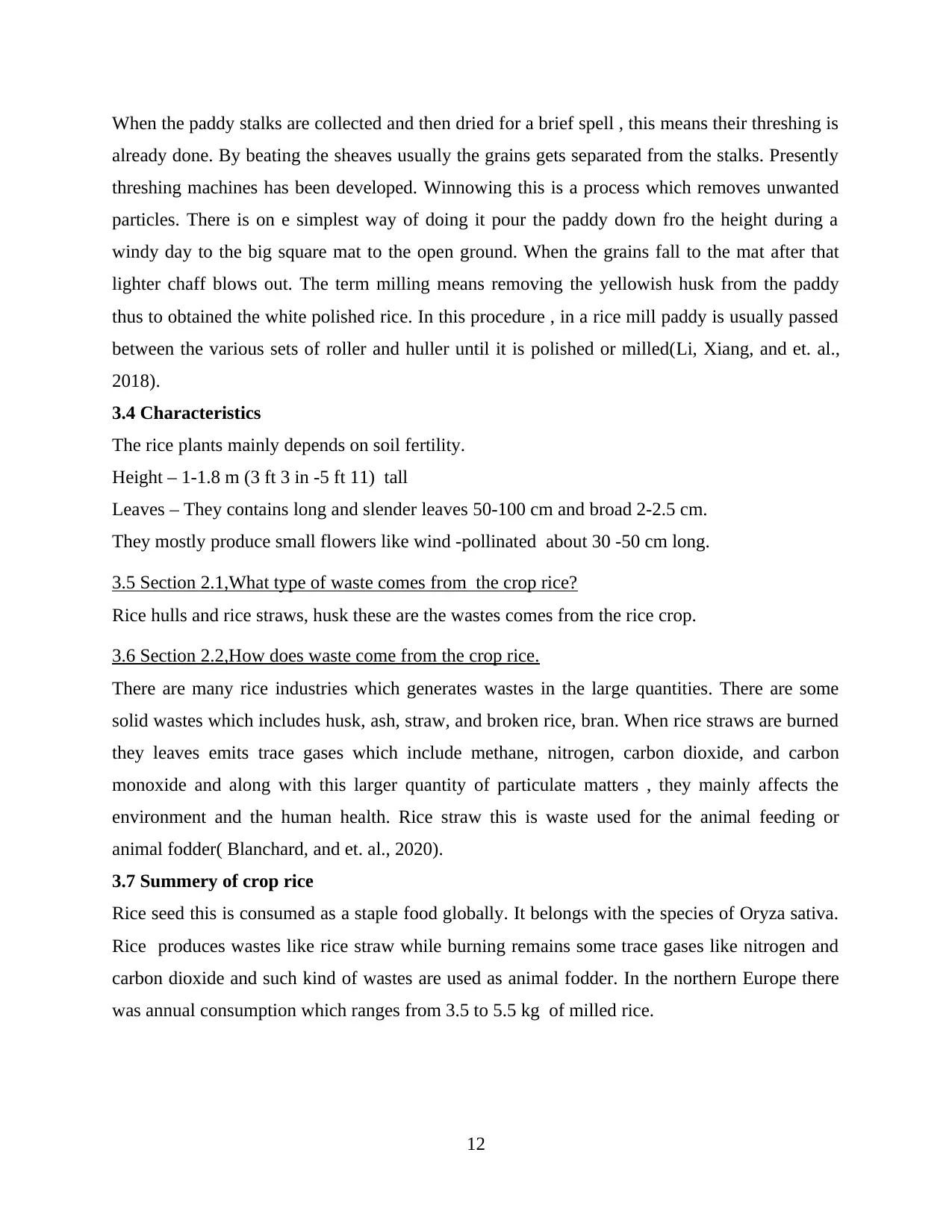
When the paddy stalks are collected and then dried for a brief spell , this means their threshing is
already done. By beating the sheaves usually the grains gets separated from the stalks. Presently
threshing machines has been developed. Winnowing this is a process which removes unwanted
particles. There is on e simplest way of doing it pour the paddy down fro the height during a
windy day to the big square mat to the open ground. When the grains fall to the mat after that
lighter chaff blows out. The term milling means removing the yellowish husk from the paddy
thus to obtained the white polished rice. In this procedure , in a rice mill paddy is usually passed
between the various sets of roller and huller until it is polished or milled(Li, Xiang, and et. al.,
2018).
3.4 Characteristics
The rice plants mainly depends on soil fertility.
Height – 1-1.8 m (3 ft 3 in -5 ft 11) tall
Leaves – They contains long and slender leaves 50-100 cm and broad 2-2.5 cm.
They mostly produce small flowers like wind -pollinated about 30 -50 cm long.
3.5 Section 2.1,What type of waste comes from the crop rice?
Rice hulls and rice straws, husk these are the wastes comes from the rice crop.
3.6 Section 2.2,How does waste come from the crop rice.
There are many rice industries which generates wastes in the large quantities. There are some
solid wastes which includes husk, ash, straw, and broken rice, bran. When rice straws are burned
they leaves emits trace gases which include methane, nitrogen, carbon dioxide, and carbon
monoxide and along with this larger quantity of particulate matters , they mainly affects the
environment and the human health. Rice straw this is waste used for the animal feeding or
animal fodder( Blanchard, and et. al., 2020).
3.7 Summery of crop rice
Rice seed this is consumed as a staple food globally. It belongs with the species of Oryza sativa.
Rice produces wastes like rice straw while burning remains some trace gases like nitrogen and
carbon dioxide and such kind of wastes are used as animal fodder. In the northern Europe there
was annual consumption which ranges from 3.5 to 5.5 kg of milled rice.
12
already done. By beating the sheaves usually the grains gets separated from the stalks. Presently
threshing machines has been developed. Winnowing this is a process which removes unwanted
particles. There is on e simplest way of doing it pour the paddy down fro the height during a
windy day to the big square mat to the open ground. When the grains fall to the mat after that
lighter chaff blows out. The term milling means removing the yellowish husk from the paddy
thus to obtained the white polished rice. In this procedure , in a rice mill paddy is usually passed
between the various sets of roller and huller until it is polished or milled(Li, Xiang, and et. al.,
2018).
3.4 Characteristics
The rice plants mainly depends on soil fertility.
Height – 1-1.8 m (3 ft 3 in -5 ft 11) tall
Leaves – They contains long and slender leaves 50-100 cm and broad 2-2.5 cm.
They mostly produce small flowers like wind -pollinated about 30 -50 cm long.
3.5 Section 2.1,What type of waste comes from the crop rice?
Rice hulls and rice straws, husk these are the wastes comes from the rice crop.
3.6 Section 2.2,How does waste come from the crop rice.
There are many rice industries which generates wastes in the large quantities. There are some
solid wastes which includes husk, ash, straw, and broken rice, bran. When rice straws are burned
they leaves emits trace gases which include methane, nitrogen, carbon dioxide, and carbon
monoxide and along with this larger quantity of particulate matters , they mainly affects the
environment and the human health. Rice straw this is waste used for the animal feeding or
animal fodder( Blanchard, and et. al., 2020).
3.7 Summery of crop rice
Rice seed this is consumed as a staple food globally. It belongs with the species of Oryza sativa.
Rice produces wastes like rice straw while burning remains some trace gases like nitrogen and
carbon dioxide and such kind of wastes are used as animal fodder. In the northern Europe there
was annual consumption which ranges from 3.5 to 5.5 kg of milled rice.
12
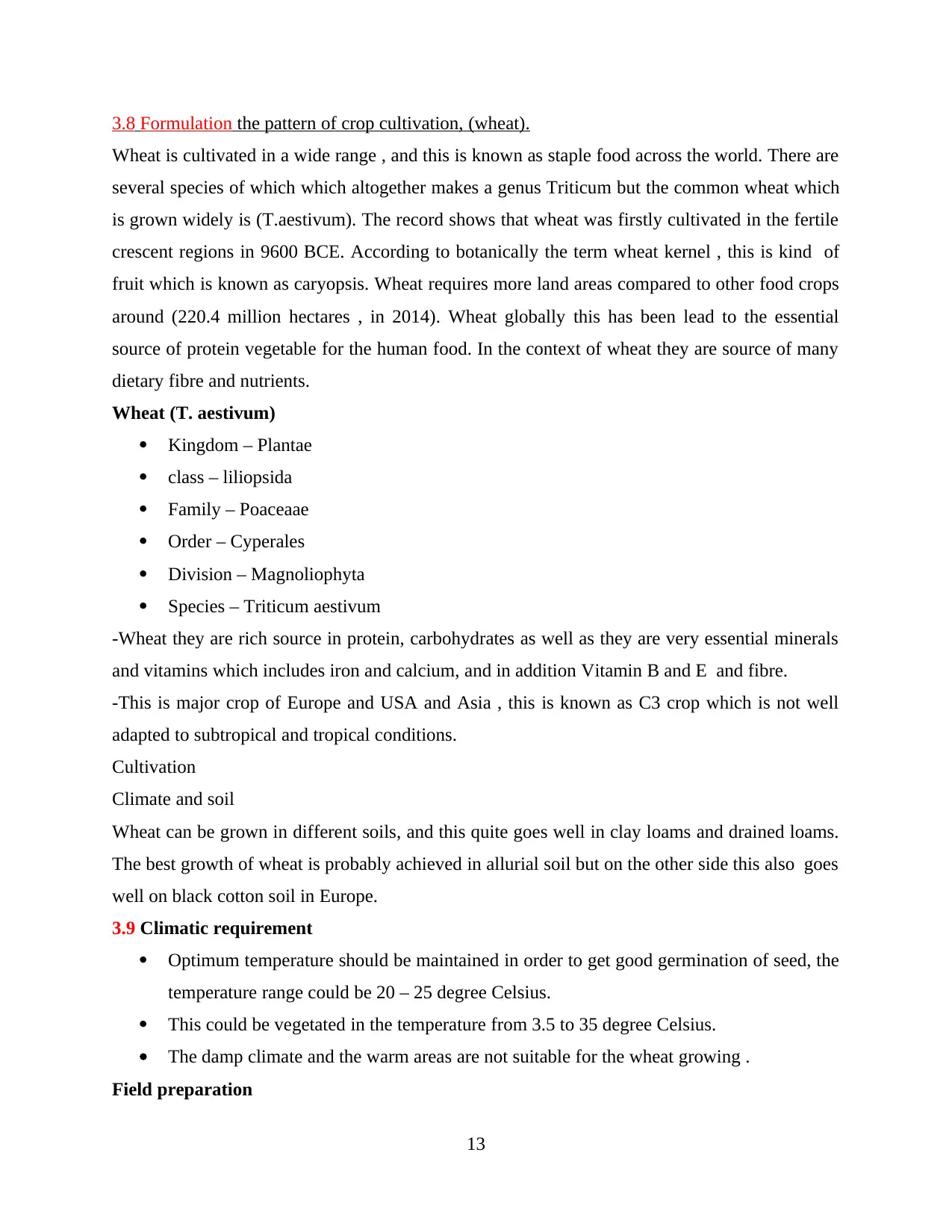
3.8 Formulation the pattern of crop cultivation, (wheat).
Wheat is cultivated in a wide range , and this is known as staple food across the world. There are
several species of which which altogether makes a genus Triticum but the common wheat which
is grown widely is (T.aestivum). The record shows that wheat was firstly cultivated in the fertile
crescent regions in 9600 BCE. According to botanically the term wheat kernel , this is kind of
fruit which is known as caryopsis. Wheat requires more land areas compared to other food crops
around (220.4 million hectares , in 2014). Wheat globally this has been lead to the essential
source of protein vegetable for the human food. In the context of wheat they are source of many
dietary fibre and nutrients.
Wheat (T. aestivum)
Kingdom – Plantae
class – liliopsida
Family – Poaceaae
Order – Cyperales
Division – Magnoliophyta
Species – Triticum aestivum
-Wheat they are rich source in protein, carbohydrates as well as they are very essential minerals
and vitamins which includes iron and calcium, and in addition Vitamin B and E and fibre.
-This is major crop of Europe and USA and Asia , this is known as C3 crop which is not well
adapted to subtropical and tropical conditions.
Cultivation
Climate and soil
Wheat can be grown in different soils, and this quite goes well in clay loams and drained loams.
The best growth of wheat is probably achieved in allurial soil but on the other side this also goes
well on black cotton soil in Europe.
3.9 Climatic requirement
Optimum temperature should be maintained in order to get good germination of seed, the
temperature range could be 20 – 25 degree Celsius.
This could be vegetated in the temperature from 3.5 to 35 degree Celsius.
The damp climate and the warm areas are not suitable for the wheat growing .
Field preparation
13
Wheat is cultivated in a wide range , and this is known as staple food across the world. There are
several species of which which altogether makes a genus Triticum but the common wheat which
is grown widely is (T.aestivum). The record shows that wheat was firstly cultivated in the fertile
crescent regions in 9600 BCE. According to botanically the term wheat kernel , this is kind of
fruit which is known as caryopsis. Wheat requires more land areas compared to other food crops
around (220.4 million hectares , in 2014). Wheat globally this has been lead to the essential
source of protein vegetable for the human food. In the context of wheat they are source of many
dietary fibre and nutrients.
Wheat (T. aestivum)
Kingdom – Plantae
class – liliopsida
Family – Poaceaae
Order – Cyperales
Division – Magnoliophyta
Species – Triticum aestivum
-Wheat they are rich source in protein, carbohydrates as well as they are very essential minerals
and vitamins which includes iron and calcium, and in addition Vitamin B and E and fibre.
-This is major crop of Europe and USA and Asia , this is known as C3 crop which is not well
adapted to subtropical and tropical conditions.
Cultivation
Climate and soil
Wheat can be grown in different soils, and this quite goes well in clay loams and drained loams.
The best growth of wheat is probably achieved in allurial soil but on the other side this also goes
well on black cotton soil in Europe.
3.9 Climatic requirement
Optimum temperature should be maintained in order to get good germination of seed, the
temperature range could be 20 – 25 degree Celsius.
This could be vegetated in the temperature from 3.5 to 35 degree Celsius.
The damp climate and the warm areas are not suitable for the wheat growing .
Field preparation
13
Paraphrase This Document
Need a fresh take? Get an instant paraphrase of this document with our AI Paraphraser

This process mainly requires powder form soil for the good growth
After the harvesting of previous crops the field should be ploughed in a proper manner as
well as harrowed at l;east 2-3 times and must be followed by the planning.
The complete wet land is required before the 7- 10 days of sowing the seeds, this is very
essential for the proper growth(Pulido, Barrena-González, Badgery, Rodrigo-Comino,
and et. al., 2018).
The light is very essential part for the cultivation of wheat and before sowing the seed.
3.10 Management practice
Fields should be ploughed deeply and in a proper manner along with this planking
should be done.
Furrow they should be kept openly during the night so the moisture could be absorbed
from dew.
The process of planking should be followed in the morning
Seed and sowing
Spacing should be well maintained
It should be row to row at least 25 cm
From plant to plant it should be 5 cm
Sowing should be done by following the process of broadcasting in the row.
Time of sowing
wheat is germinated in the first week of November
Growth stage
14
After the harvesting of previous crops the field should be ploughed in a proper manner as
well as harrowed at l;east 2-3 times and must be followed by the planning.
The complete wet land is required before the 7- 10 days of sowing the seeds, this is very
essential for the proper growth(Pulido, Barrena-González, Badgery, Rodrigo-Comino,
and et. al., 2018).
The light is very essential part for the cultivation of wheat and before sowing the seed.
3.10 Management practice
Fields should be ploughed deeply and in a proper manner along with this planking
should be done.
Furrow they should be kept openly during the night so the moisture could be absorbed
from dew.
The process of planking should be followed in the morning
Seed and sowing
Spacing should be well maintained
It should be row to row at least 25 cm
From plant to plant it should be 5 cm
Sowing should be done by following the process of broadcasting in the row.
Time of sowing
wheat is germinated in the first week of November
Growth stage
14
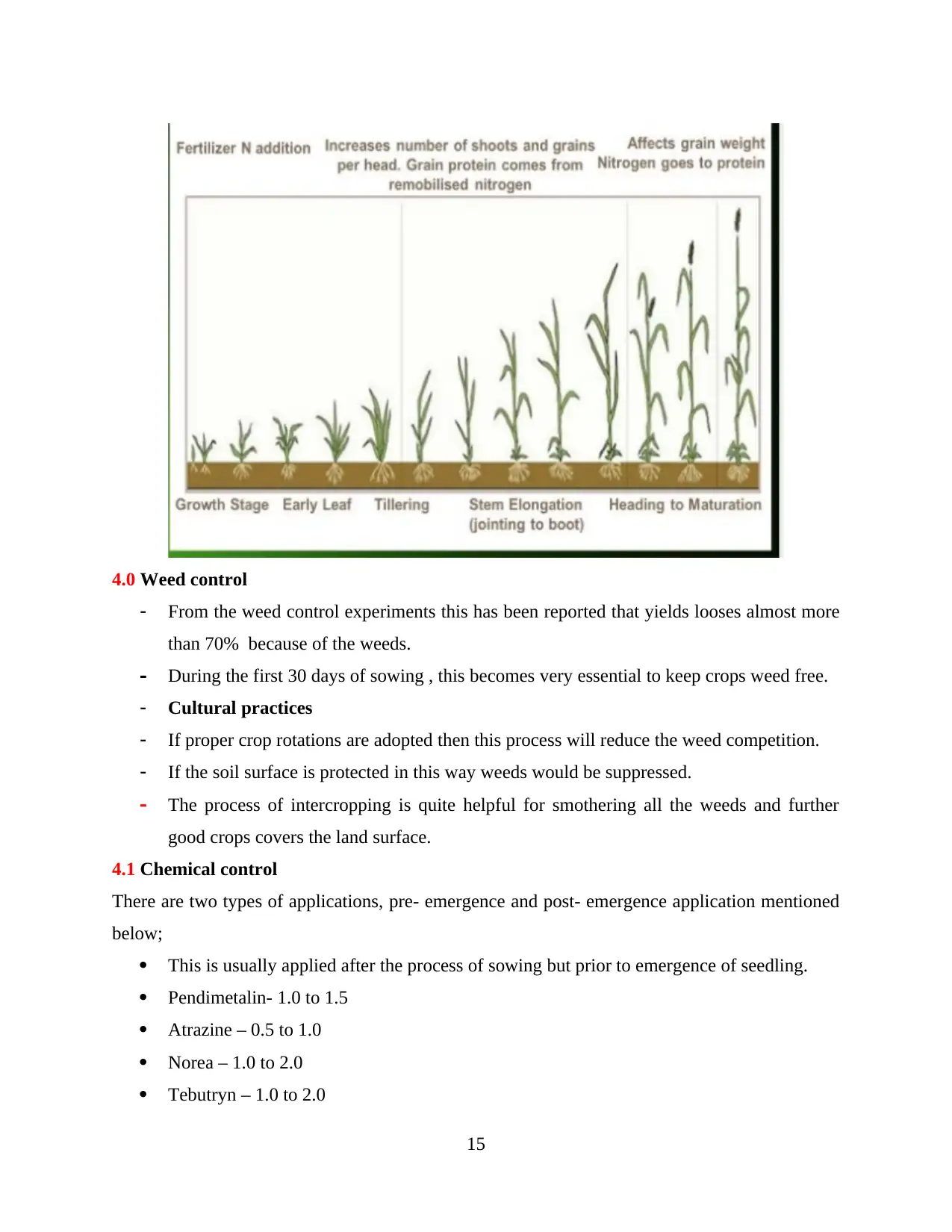
4.0 Weed control
From the weed control experiments this has been reported that yields looses almost more
than 70% because of the weeds.
During the first 30 days of sowing , this becomes very essential to keep crops weed free.
Cultural practices
If proper crop rotations are adopted then this process will reduce the weed competition.
If the soil surface is protected in this way weeds would be suppressed.
The process of intercropping is quite helpful for smothering all the weeds and further
good crops covers the land surface.
4.1 Chemical control
There are two types of applications, pre- emergence and post- emergence application mentioned
below;
This is usually applied after the process of sowing but prior to emergence of seedling.
Pendimetalin- 1.0 to 1.5
Atrazine – 0.5 to 1.0
Norea – 1.0 to 2.0
Tebutryn – 1.0 to 2.0
15
From the weed control experiments this has been reported that yields looses almost more
than 70% because of the weeds.
During the first 30 days of sowing , this becomes very essential to keep crops weed free.
Cultural practices
If proper crop rotations are adopted then this process will reduce the weed competition.
If the soil surface is protected in this way weeds would be suppressed.
The process of intercropping is quite helpful for smothering all the weeds and further
good crops covers the land surface.
4.1 Chemical control
There are two types of applications, pre- emergence and post- emergence application mentioned
below;
This is usually applied after the process of sowing but prior to emergence of seedling.
Pendimetalin- 1.0 to 1.5
Atrazine – 0.5 to 1.0
Norea – 1.0 to 2.0
Tebutryn – 1.0 to 2.0
15
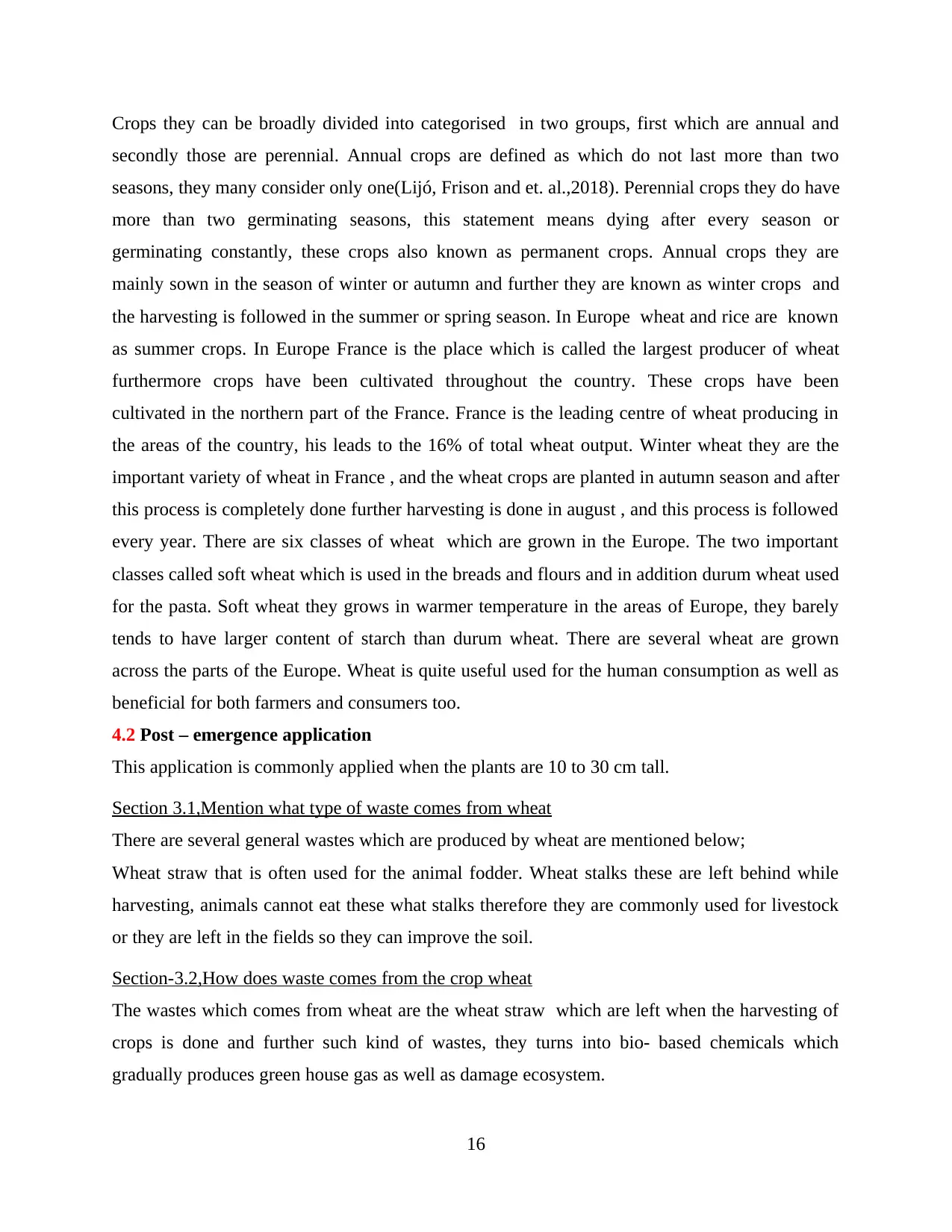
Crops they can be broadly divided into categorised in two groups, first which are annual and
secondly those are perennial. Annual crops are defined as which do not last more than two
seasons, they many consider only one(Lijó, Frison and et. al.,2018). Perennial crops they do have
more than two germinating seasons, this statement means dying after every season or
germinating constantly, these crops also known as permanent crops. Annual crops they are
mainly sown in the season of winter or autumn and further they are known as winter crops and
the harvesting is followed in the summer or spring season. In Europe wheat and rice are known
as summer crops. In Europe France is the place which is called the largest producer of wheat
furthermore crops have been cultivated throughout the country. These crops have been
cultivated in the northern part of the France. France is the leading centre of wheat producing in
the areas of the country, his leads to the 16% of total wheat output. Winter wheat they are the
important variety of wheat in France , and the wheat crops are planted in autumn season and after
this process is completely done further harvesting is done in august , and this process is followed
every year. There are six classes of wheat which are grown in the Europe. The two important
classes called soft wheat which is used in the breads and flours and in addition durum wheat used
for the pasta. Soft wheat they grows in warmer temperature in the areas of Europe, they barely
tends to have larger content of starch than durum wheat. There are several wheat are grown
across the parts of the Europe. Wheat is quite useful used for the human consumption as well as
beneficial for both farmers and consumers too.
4.2 Post – emergence application
This application is commonly applied when the plants are 10 to 30 cm tall.
Section 3.1,Mention what type of waste comes from wheat
There are several general wastes which are produced by wheat are mentioned below;
Wheat straw that is often used for the animal fodder. Wheat stalks these are left behind while
harvesting, animals cannot eat these what stalks therefore they are commonly used for livestock
or they are left in the fields so they can improve the soil.
Section-3.2,How does waste comes from the crop wheat
The wastes which comes from wheat are the wheat straw which are left when the harvesting of
crops is done and further such kind of wastes, they turns into bio- based chemicals which
gradually produces green house gas as well as damage ecosystem.
16
secondly those are perennial. Annual crops are defined as which do not last more than two
seasons, they many consider only one(Lijó, Frison and et. al.,2018). Perennial crops they do have
more than two germinating seasons, this statement means dying after every season or
germinating constantly, these crops also known as permanent crops. Annual crops they are
mainly sown in the season of winter or autumn and further they are known as winter crops and
the harvesting is followed in the summer or spring season. In Europe wheat and rice are known
as summer crops. In Europe France is the place which is called the largest producer of wheat
furthermore crops have been cultivated throughout the country. These crops have been
cultivated in the northern part of the France. France is the leading centre of wheat producing in
the areas of the country, his leads to the 16% of total wheat output. Winter wheat they are the
important variety of wheat in France , and the wheat crops are planted in autumn season and after
this process is completely done further harvesting is done in august , and this process is followed
every year. There are six classes of wheat which are grown in the Europe. The two important
classes called soft wheat which is used in the breads and flours and in addition durum wheat used
for the pasta. Soft wheat they grows in warmer temperature in the areas of Europe, they barely
tends to have larger content of starch than durum wheat. There are several wheat are grown
across the parts of the Europe. Wheat is quite useful used for the human consumption as well as
beneficial for both farmers and consumers too.
4.2 Post – emergence application
This application is commonly applied when the plants are 10 to 30 cm tall.
Section 3.1,Mention what type of waste comes from wheat
There are several general wastes which are produced by wheat are mentioned below;
Wheat straw that is often used for the animal fodder. Wheat stalks these are left behind while
harvesting, animals cannot eat these what stalks therefore they are commonly used for livestock
or they are left in the fields so they can improve the soil.
Section-3.2,How does waste comes from the crop wheat
The wastes which comes from wheat are the wheat straw which are left when the harvesting of
crops is done and further such kind of wastes, they turns into bio- based chemicals which
gradually produces green house gas as well as damage ecosystem.
16
Secure Best Marks with AI Grader
Need help grading? Try our AI Grader for instant feedback on your assignments.
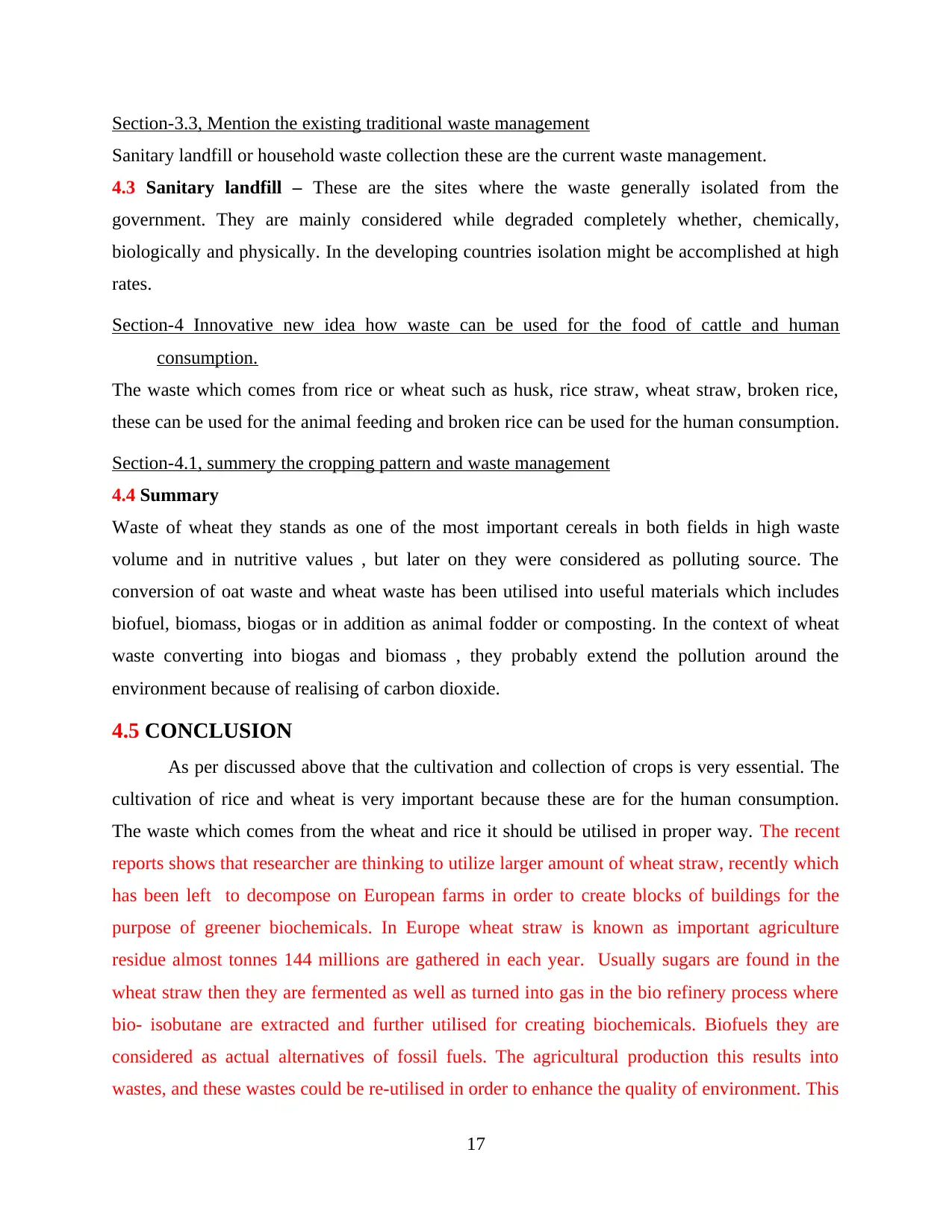
Section-3.3, Mention the existing traditional waste management
Sanitary landfill or household waste collection these are the current waste management.
4.3 Sanitary landfill – These are the sites where the waste generally isolated from the
government. They are mainly considered while degraded completely whether, chemically,
biologically and physically. In the developing countries isolation might be accomplished at high
rates.
Section-4 Innovative new idea how waste can be used for the food of cattle and human
consumption.
The waste which comes from rice or wheat such as husk, rice straw, wheat straw, broken rice,
these can be used for the animal feeding and broken rice can be used for the human consumption.
Section-4.1, summery the cropping pattern and waste management
4.4 Summary
Waste of wheat they stands as one of the most important cereals in both fields in high waste
volume and in nutritive values , but later on they were considered as polluting source. The
conversion of oat waste and wheat waste has been utilised into useful materials which includes
biofuel, biomass, biogas or in addition as animal fodder or composting. In the context of wheat
waste converting into biogas and biomass , they probably extend the pollution around the
environment because of realising of carbon dioxide.
4.5 CONCLUSION
As per discussed above that the cultivation and collection of crops is very essential. The
cultivation of rice and wheat is very important because these are for the human consumption.
The waste which comes from the wheat and rice it should be utilised in proper way. The recent
reports shows that researcher are thinking to utilize larger amount of wheat straw, recently which
has been left to decompose on European farms in order to create blocks of buildings for the
purpose of greener biochemicals. In Europe wheat straw is known as important agriculture
residue almost tonnes 144 millions are gathered in each year. Usually sugars are found in the
wheat straw then they are fermented as well as turned into gas in the bio refinery process where
bio- isobutane are extracted and further utilised for creating biochemicals. Biofuels they are
considered as actual alternatives of fossil fuels. The agricultural production this results into
wastes, and these wastes could be re-utilised in order to enhance the quality of environment. This
17
Sanitary landfill or household waste collection these are the current waste management.
4.3 Sanitary landfill – These are the sites where the waste generally isolated from the
government. They are mainly considered while degraded completely whether, chemically,
biologically and physically. In the developing countries isolation might be accomplished at high
rates.
Section-4 Innovative new idea how waste can be used for the food of cattle and human
consumption.
The waste which comes from rice or wheat such as husk, rice straw, wheat straw, broken rice,
these can be used for the animal feeding and broken rice can be used for the human consumption.
Section-4.1, summery the cropping pattern and waste management
4.4 Summary
Waste of wheat they stands as one of the most important cereals in both fields in high waste
volume and in nutritive values , but later on they were considered as polluting source. The
conversion of oat waste and wheat waste has been utilised into useful materials which includes
biofuel, biomass, biogas or in addition as animal fodder or composting. In the context of wheat
waste converting into biogas and biomass , they probably extend the pollution around the
environment because of realising of carbon dioxide.
4.5 CONCLUSION
As per discussed above that the cultivation and collection of crops is very essential. The
cultivation of rice and wheat is very important because these are for the human consumption.
The waste which comes from the wheat and rice it should be utilised in proper way. The recent
reports shows that researcher are thinking to utilize larger amount of wheat straw, recently which
has been left to decompose on European farms in order to create blocks of buildings for the
purpose of greener biochemicals. In Europe wheat straw is known as important agriculture
residue almost tonnes 144 millions are gathered in each year. Usually sugars are found in the
wheat straw then they are fermented as well as turned into gas in the bio refinery process where
bio- isobutane are extracted and further utilised for creating biochemicals. Biofuels they are
considered as actual alternatives of fossil fuels. The agricultural production this results into
wastes, and these wastes could be re-utilised in order to enhance the quality of environment. This
17
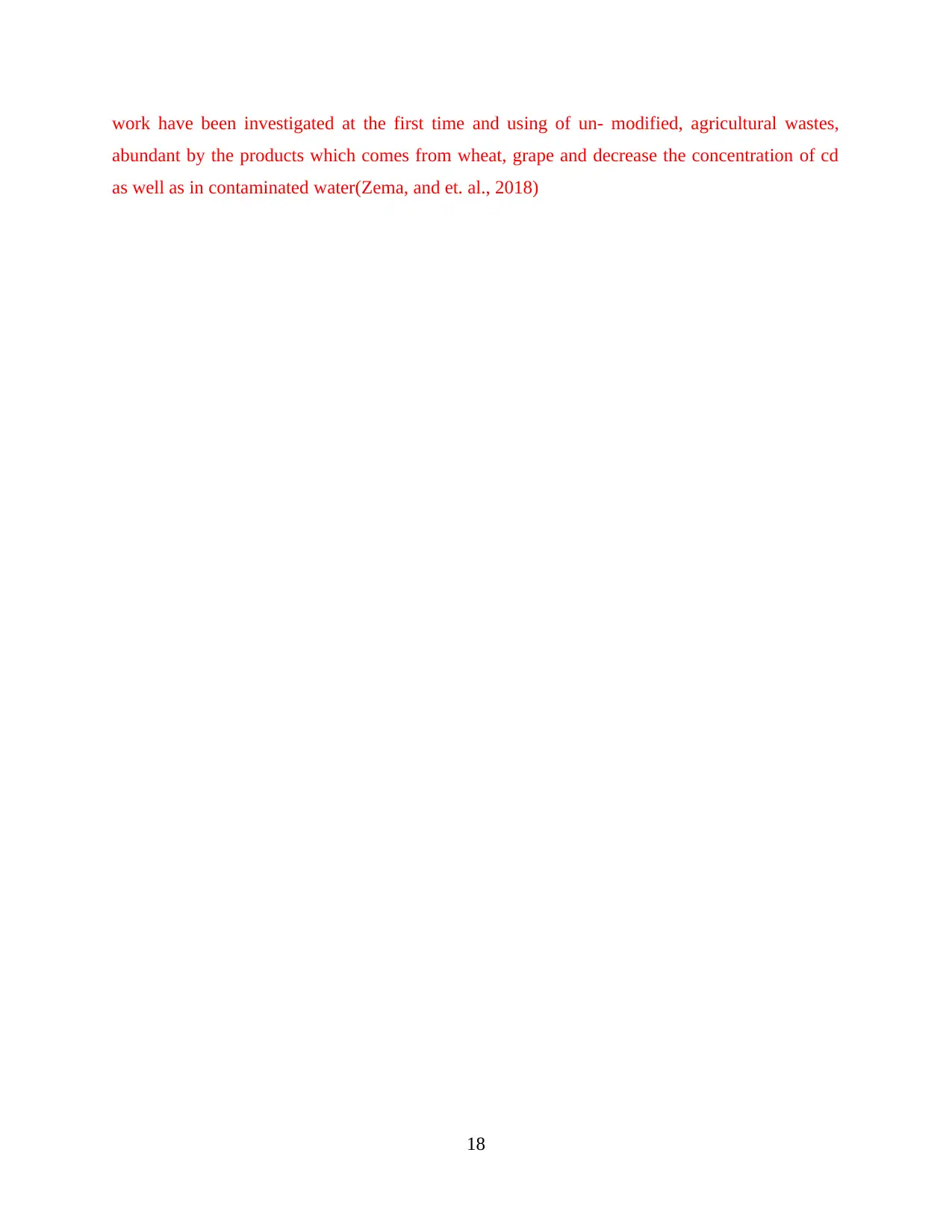
work have been investigated at the first time and using of un- modified, agricultural wastes,
abundant by the products which comes from wheat, grape and decrease the concentration of cd
as well as in contaminated water(Zema, and et. al., 2018)
18
abundant by the products which comes from wheat, grape and decrease the concentration of cd
as well as in contaminated water(Zema, and et. al., 2018)
18
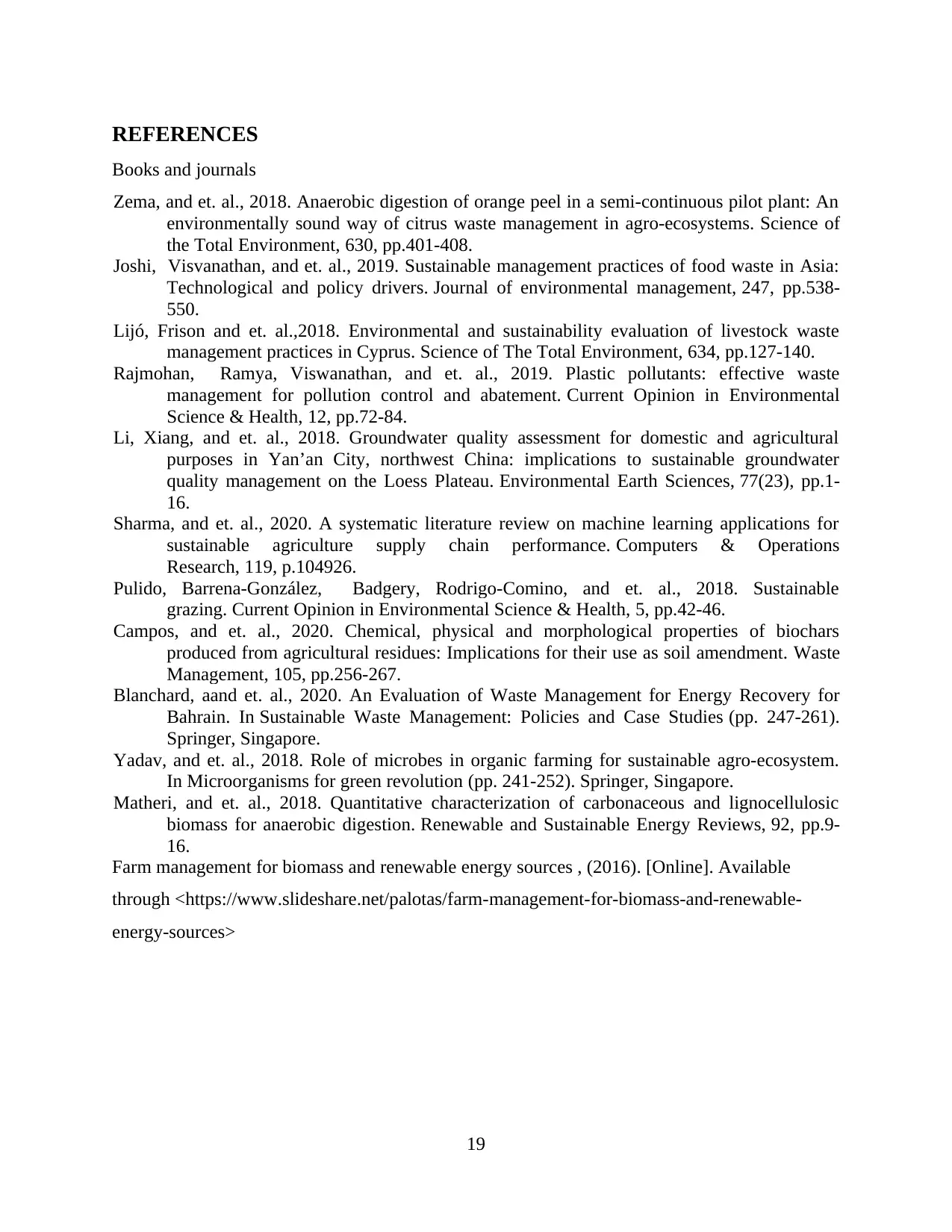
REFERENCES
Books and journals
Zema, and et. al., 2018. Anaerobic digestion of orange peel in a semi-continuous pilot plant: An
environmentally sound way of citrus waste management in agro-ecosystems. Science of
the Total Environment, 630, pp.401-408.
Joshi, Visvanathan, and et. al., 2019. Sustainable management practices of food waste in Asia:
Technological and policy drivers. Journal of environmental management, 247, pp.538-
550.
Lijó, Frison and et. al.,2018. Environmental and sustainability evaluation of livestock waste
management practices in Cyprus. Science of The Total Environment, 634, pp.127-140.
Rajmohan, Ramya, Viswanathan, and et. al., 2019. Plastic pollutants: effective waste
management for pollution control and abatement. Current Opinion in Environmental
Science & Health, 12, pp.72-84.
Li, Xiang, and et. al., 2018. Groundwater quality assessment for domestic and agricultural
purposes in Yan’an City, northwest China: implications to sustainable groundwater
quality management on the Loess Plateau. Environmental Earth Sciences, 77(23), pp.1-
16.
Sharma, and et. al., 2020. A systematic literature review on machine learning applications for
sustainable agriculture supply chain performance. Computers & Operations
Research, 119, p.104926.
Pulido, Barrena-González, Badgery, Rodrigo-Comino, and et. al., 2018. Sustainable
grazing. Current Opinion in Environmental Science & Health, 5, pp.42-46.
Campos, and et. al., 2020. Chemical, physical and morphological properties of biochars
produced from agricultural residues: Implications for their use as soil amendment. Waste
Management, 105, pp.256-267.
Blanchard, aand et. al., 2020. An Evaluation of Waste Management for Energy Recovery for
Bahrain. In Sustainable Waste Management: Policies and Case Studies (pp. 247-261).
Springer, Singapore.
Yadav, and et. al., 2018. Role of microbes in organic farming for sustainable agro-ecosystem.
In Microorganisms for green revolution (pp. 241-252). Springer, Singapore.
Matheri, and et. al., 2018. Quantitative characterization of carbonaceous and lignocellulosic
biomass for anaerobic digestion. Renewable and Sustainable Energy Reviews, 92, pp.9-
16.
Farm management for biomass and renewable energy sources , (2016). [Online]. Available
through <https://www.slideshare.net/palotas/farm-management-for-biomass-and-renewable-
energy-sources>
19
Books and journals
Zema, and et. al., 2018. Anaerobic digestion of orange peel in a semi-continuous pilot plant: An
environmentally sound way of citrus waste management in agro-ecosystems. Science of
the Total Environment, 630, pp.401-408.
Joshi, Visvanathan, and et. al., 2019. Sustainable management practices of food waste in Asia:
Technological and policy drivers. Journal of environmental management, 247, pp.538-
550.
Lijó, Frison and et. al.,2018. Environmental and sustainability evaluation of livestock waste
management practices in Cyprus. Science of The Total Environment, 634, pp.127-140.
Rajmohan, Ramya, Viswanathan, and et. al., 2019. Plastic pollutants: effective waste
management for pollution control and abatement. Current Opinion in Environmental
Science & Health, 12, pp.72-84.
Li, Xiang, and et. al., 2018. Groundwater quality assessment for domestic and agricultural
purposes in Yan’an City, northwest China: implications to sustainable groundwater
quality management on the Loess Plateau. Environmental Earth Sciences, 77(23), pp.1-
16.
Sharma, and et. al., 2020. A systematic literature review on machine learning applications for
sustainable agriculture supply chain performance. Computers & Operations
Research, 119, p.104926.
Pulido, Barrena-González, Badgery, Rodrigo-Comino, and et. al., 2018. Sustainable
grazing. Current Opinion in Environmental Science & Health, 5, pp.42-46.
Campos, and et. al., 2020. Chemical, physical and morphological properties of biochars
produced from agricultural residues: Implications for their use as soil amendment. Waste
Management, 105, pp.256-267.
Blanchard, aand et. al., 2020. An Evaluation of Waste Management for Energy Recovery for
Bahrain. In Sustainable Waste Management: Policies and Case Studies (pp. 247-261).
Springer, Singapore.
Yadav, and et. al., 2018. Role of microbes in organic farming for sustainable agro-ecosystem.
In Microorganisms for green revolution (pp. 241-252). Springer, Singapore.
Matheri, and et. al., 2018. Quantitative characterization of carbonaceous and lignocellulosic
biomass for anaerobic digestion. Renewable and Sustainable Energy Reviews, 92, pp.9-
16.
Farm management for biomass and renewable energy sources , (2016). [Online]. Available
through <https://www.slideshare.net/palotas/farm-management-for-biomass-and-renewable-
energy-sources>
19
Paraphrase This Document
Need a fresh take? Get an instant paraphrase of this document with our AI Paraphraser
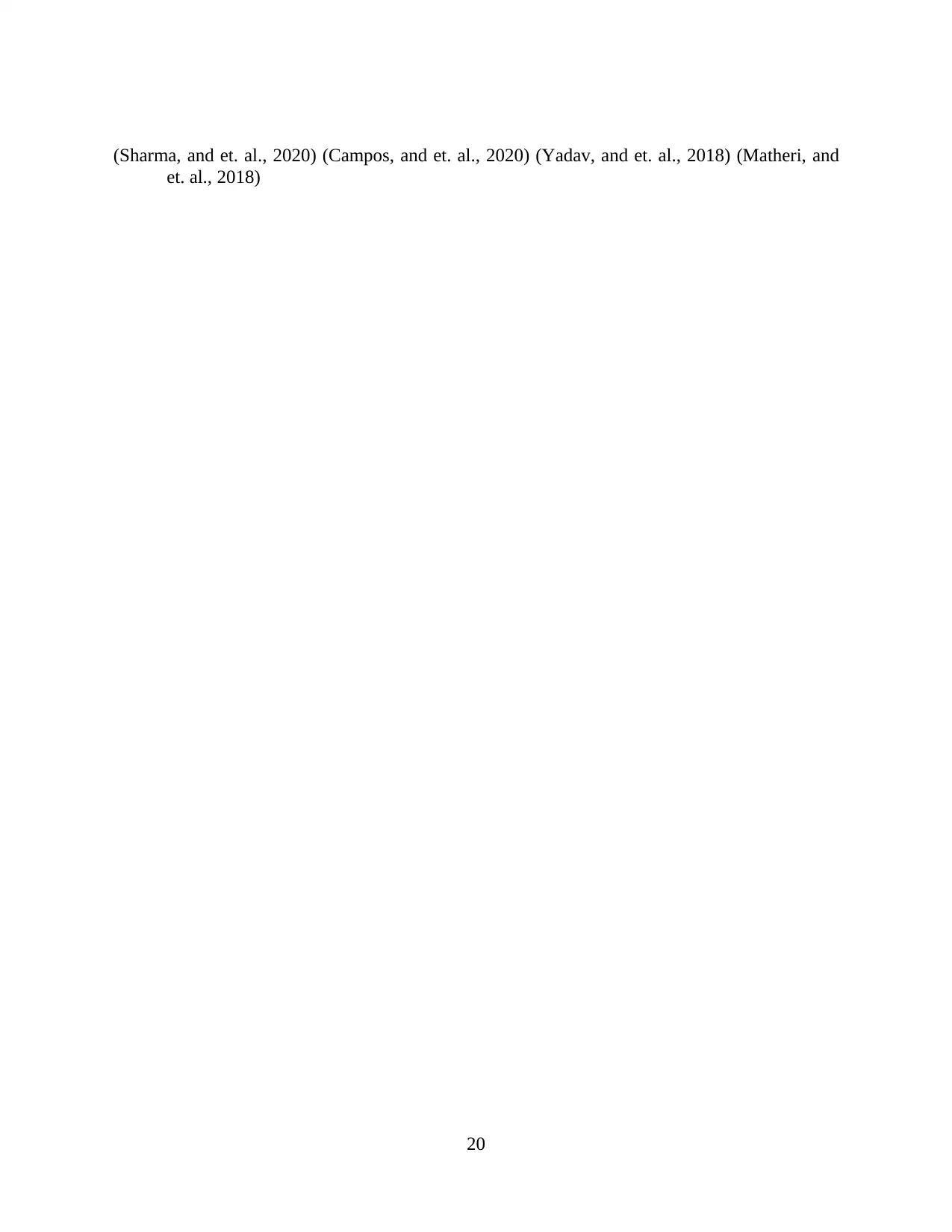
(Sharma, and et. al., 2020) (Campos, and et. al., 2020) (Yadav, and et. al., 2018) (Matheri, and
et. al., 2018)
20
et. al., 2018)
20
1 out of 20
Related Documents
Your All-in-One AI-Powered Toolkit for Academic Success.
+13062052269
info@desklib.com
Available 24*7 on WhatsApp / Email
![[object Object]](/_next/static/media/star-bottom.7253800d.svg)
Unlock your academic potential
© 2024 | Zucol Services PVT LTD | All rights reserved.



